

How to Write a Long Essay

How to Write a One Page Essay
Writing an essay as part of a school assignment or a project can be a very tedious task, especially if that essay needs to be long. Even the most confident writers may have no trouble writing a few pages for an assignment but may find it challenging to extend that word count as much as possible. If you're assigned a long essay for one of your classes, there's no reason to worry. With some useful tips at your disposal, you can stretch that essay out without making it sound repetitive or boring the reader with an influx of irrelevant information.
What Is a Long Essay?
A long essay is any essay that tends to be longer than three pages or 3,000 words or more. Of course, the definition of a long essay will differ from one classroom to another, depending on the age and level of the students. And even if you're a college student, you may have some professors who consider a five-page essay to be the average, while another teacher considers five pages to be too much. Therefore, it's important to check with your teacher, though they'll usually clarify this when giving the assignment.
Sometimes, the term "long" applies to how many pages, and sometimes it applies to how many paragraphs or words need to be in the essay. Again, this all depends on your teacher, your school's requirements and the nature of the assignment. Either way, hearing your teacher say that you must write a long essay for your next assignment can certainly cause a lot of stress. The good news is that writing a long essay can be much easier than writing a short essay, especially if you're given some meaningful advice.
Why Would You Be Required to Write a Long Essay?
There are many reasons why teachers would assign a long essay to their students. First of all, writing a long essay is an opportunity for a student to really put his or her writing skills to the test. By the time students get to college, they already have an idea as to how to write a decent paper, but perhaps it's within limits. College professors need to make sure that students are able to write well, because eventually, these students may need to write a thesis or dissertation, and there really is no longer essay than that.
So even though you may think of writing a long essay as a torturous assignment, it's actually a great opportunity to practice a very specific skill that will definitely come in handy in other areas of your life. And, if you build up the right mindset for yourself, writing that long essay shouldn't be any more difficult than any other assignment you've been required to complete.
What Is the Standard Essay Format?
There's a standard essay format understood by most English students around the world. This is how essay writing can be taught in a universal way so that students are successful at writing essays no matter where they're studying. A standard essay format typically includes an introduction, three body paragraphs and a conclusion. Of course, the older a student gets and the more experience they have in school, their essays will gradually get longer and will need to require more detail and features (for instance, citing sources) in order to meet the requirements set by the teacher.
When you need to write a long essay, you can and should still base your writing off of this standard essay format. The only difference is that instead of having three body paragraphs, you're going to have a lot more in order to reach the word count or page requirement that you need to meet. This isn't as hard as it sounds. Instead of squeezing your main idea into one paragraph, try to add more examples and details to make it longer. Also, try to think of other key points that support your essay's theme that might not be so obvious at first.
Start Ahead of Time
The best way to relieve the stress that comes with having to write a long essay is to start ahead of time. Too many college students (and high school students) wait until the last possible minute to write an essay. Though some students may certainly be able to get away with this, it'll be a lot harder when it comes to writing a longer essay. Therefore, make sure you give yourself plenty of time to complete the assignment. It may work better for some people to do a little bit each day until they reach their goal. For instance, if you're required to write 3,000 words for your long essay, then you may feel better writing just 500 words a day over a couple of days instead of trying to bang it all out at once.
How to Write a 3,000 Word Essay in a Day
Some students rather get the hard work out of the way, instead of letting it drag out over a week. Writing a long essay of 3,000 words can be done in a day if you just put your mind to it. Do the following:
- Don't schedule any other appointments or assignments for the day.
- Put away any potential distractions, like your phone or the TV.
- Stay off of social media.
- Work somewhere quiet, like the library or a calm cafe.
- Take breaks every few paragraphs.
- Set a timer for ten minutes and try to work the entire time without stopping.
Create Your Essay Structure
Once you've decided whether or not you're going to write the essay over a couple of days or in just one day, it's time to start writing the actual essay. Like with any writing assignment, the first thing you should do is create an outline and organize your overall essay structure. If you need to write around five pages, which makes sense for a long essay, then you should make an outline that will support that. Take a look at an essay format example to get an idea of how yours should be:
- Introduction (more than two paragraphs)
- A starter question (something for the reader to consider)
- Body "paragraph/idea" one (four paragraphs on average)
- Body "paragraph/idea" two (four paragraphs on average]
- Body "paragraph/idea" three (four paragraphs on average)
- A conclusion
If you're wondering how on earth you're going to create a body section that's four paragraphs long, try to think of one main idea and three examples that tie together with it. For instance, if your long essay is an argumentative piece about "The Importance of Waiting Until You're Financially Stable to Have Children" you can think of at least four key reasons why:
- You won't have to struggle to pay for their needs.
- You can give them more opportunities.
- You can travel as a family.
- You can put away money for their college tuition.
For the first idea, you can talk about this point in very general terms. Then, you can write three more paragraphs underneath that, with each paragraph discussing a specific example. The second paragraph, for example, can be about paying for things like diapers, clothes, formula, etc., and how much each item costs. The second example can be about paying for things when the child gets a little older, like their food, their school supplies, etc. Lastly, the third example (and the fourth paragraph in this section) can discuss paying for things that the child will need as a teenager, such as more clothes, sports uniforms, dental work, etc.
Did You Answer All the Questions?
After you feel like you've exhausted all examples, but you're still under word count or page count, go back and make sure you've answered all the questions. These questions may have been questions in the rubric or the writing prompt that your teacher provided, or they may be questions that you've thought of on your own. In fact, when you start thinking of what to write about, you should brainstorm some questions that a reader may want to find the answer to about the topic, and you should try to answer these throughout your essay. Creating more potential questions can help you reach your word count faster.
Can You Change Words?
If you're close to reaching your word count but you're still not quite there, then go back and see if you can change any of the language in your essay to make it longer. For example, if you have a lot of contractions in your paper (can't, won't, isn't, they're) go back and make them two words instead of contractions, and do this throughout the entire essay. This is a great solution because it won't take away from the readership of your essay, and while this won't extend the word count too much, it will definitely help a bit.
Think of Additional Details You Can Add
In addition to changing contractions, you can also think of other details you can add to elongate your essay. There are always more examples you can add or more information you can research that will not only resonate with the reader but increase your overall word count or page count.
For example, if you're talking about how parents who decide to have children once they're financially stable will have the opportunity to put more money toward their child's tuition, then you can go back and add plenty of detail supporting this argument. Did you give an example of how much tuition costs? Did you add details about what parents can do with the money if their children decide not to go to college? What about the different types of college funds that exist? These are all details you can add that will increase the length of your essay, while also adding value.
However, when you do this, keep in mind that you want to be very careful not to add too much "fluff." Fluff is when you add information or details that simply aren't valuable to the writing itself. It makes the reader (who in most cases is your teacher and the one grading the assignment) want to skim over your piece, and this can lead to him or her giving you a lower grade.
Edit, Edit, Edit
Last but not least, in order to write a long essay, you must have the capacity to edit your work. Editing not only helps to ensure your paper is long enough, reads well, and is free from grammatical errors, but it will also give you an opportunity to add in more information here and there. To edit, you should always read out loud to yourself, and take a break from your work, so you can revisit it with a fresh pair of eyes. You can easily check if you've reached the length requirements by clicking on "word count" or counting the number of pages yourself, though your document will reveal this as you scroll down.
Related Articles

How to Write an Advantages and Disadvantages Essay

How to Make an Essay Longer

How to Write an Essay Fast

Problems That Students Encounter With Essay Writing

How to Write a 3,000 Word Essay

Personal Statement for scholarship: How to Write One, How long Does ...

College Essay Ideas

10 Good Transitions for a Conclusion Paragraph
- Save the Student: How to Write a 3,000 Word Essay in a Day
- International Student: General Essay Writing Tips
- You may want to have a friend read through your essay. He may catch mistakes that you have missed.
Hana LaRock is a freelance content writer from New York, currently living in Mexico. Before becoming a writer, Hana worked as a teacher for several years in the U.S. and around the world. She has her teaching certification in Elementary Education and Special Education, as well as a TESOL certification. Please visit her website, www.hanalarockwriting.com, to learn more.
What are your chances of acceptance?
Calculate for all schools, your chance of acceptance.
Your chancing factors
Extracurriculars.
How Long Should Your College Essay Be? What Is the Ideal Length?
What’s covered: , personal statement length vs. supplemental essay length, are college essay word limits hard, what if a college essay word count isn’t given, what if you need to submit a graded paper, where to get your essays edited.
Students often spend hours agonizing over the best topics for their college essays. While it’s natural to wonder whether your personal statement is original or compelling enough, there’s one aspect of the process that shouldn’t cause you undue stress—how many words should a college essay be? Fortunately, with a little research, you can uncover the ideal college essay length for all your applications.
Unlike high school assignments, which typically have a strict page requirement, most colleges provide a word limit or word range for their application essays. This practice helps ensure that essays are the same length regardless of font or formatting. A good guideline is that students should strive to get as close as possible to the upper limit of the word range without exceeding it. Keep reading to learn more about best practices for college essay length.
How many words should a college essay be? Personal statements are generally 500-650 words. For example, the Common Application , which can be used to apply to more than 800 colleges, requires an essay ranging from 250-650 words . Similarly, the Coalition Application , which has 150 member schools, features an essay with a recommended length of 500-650 words.
650 words is the most common limit for your personal statement, but some schools may ask students to write more or less. For example, ApplyTexas , a platform used to apply to Texas public universities and other select colleges, requests essays with requirements that vary by school. For example, students applying to UT Austin will need to submit an essay of 500-700 words, along with three short-answer questions of 250-300 words each.
On the other hand, the University of California (UC) application includes a Personal Insight section with eight prompts . Students are asked to respond to any four of these prompts, with each response topping out at 350 words.
Additionally, some schools request a few supplemental essays, which are typically shorter than a personal statement. These questions are designed to gain more information about a student’s interests and abilities, and may include topics like your reasons for wanting to attend their school, your desired major, or your favorite activity.
Most schools require 1-3 supplemental essays, though some may require more or none at all (see our list of top colleges without supplemental essays ). These essays tend to be around 250 words, but some may be just as long as your main essay. For example, Cornell requires applicants to write a second supplemental essay (of 650 words max) that is specific to the program they’re applying to. The exception to this is the Cornell College of Engineering, for which applicants are required to compose two supplemental essays of 250 words max each.
For best results, keep your essays within the word range provided. While you don’t have to hit the count exactly, you should aim to stay within a 10% difference of the upper limit—without including fluff or filler. For example, if the school requests 500 words, try to ensure that your essay is between 450 and 500 words.
For the Common App, try to stay within 550-650 words, even though the given range is 250-650. Any submission shorter than 500 words will make it look as though you simply didn’t care enough to give your best effort. An essay shorter than 500 words won’t be long enough to truly share who you are and what matters to you.
Exceeding the word count isn’t an option—the application portal cuts off anything over the maximum number of allowed words. This is something you want to be particularly careful of if you’re drafting your essay in a Word or Google document and pasting it into the application.
Although most schools provide applicants with a specific word count, some offer more general guidelines. For example, a college may ask for a particular number of pages or paragraphs.
If you aren’t given a word count, try to adhere to the best practices and conventions of writing. Avoid writing especially short or overly long paragraphs—250 words per paragraph is generally a safe upper limit. If you’re asked to write a certain number of pages, single- or double-spaced, stick to a standard font and font size (like 12-point Times New Roman).
In the event that the college doesn’t offer any guidelines at all, aim for an essay length of around 500 words.
While essays are the most commonly requested writing sample, some colleges ask for additional pieces of content. For example, Princeton University requires students to submit a previously graded paper for evaluation .
Princeton offers guidelines that cover length, but if another school requests an old paper and doesn’t offer length requirements, a paper ranging from 3-5 pages should yield the best results. The goal is to select a paper long enough to showcase your writing skills and unique voice, but short enough that the admissions officer doesn’t get bored reading it.
Is your essay effective while staying within the required word count? It’s hard to evaluate your own writing, especially after rereading it numerous times. CollegeVine’s free Peer Essay Review provides an opportunity to have your essay reviewed by a fellow student, for free. Similarly, you can help other students by reviewing their essays—this is a great way to refine your own writing skills.
Expert advice is also available. CollegeVine’s advisors are prepared to help you perfect your personal statement and submit a successful application to your top schools. Find the right advisor for you to improve your chances of getting into your dream school!
Related CollegeVine Blog Posts

How Long Is an Essay? The Ultimate Essay Length Guide
It’s safe to say that most students struggle with the word limit within an essay. Sometimes, it’s hard to find ideas for a text and meet the word requirement for every part of the paper. With so many factors influencing essay length, it’s easy to get confused.
Our specialists will write a custom essay specially for you!

Luckily, our custom-writing team has your back. In this article, our custom-writing experts will answer all your questions regarding essay length. We will also help you write papers with an ideal number of words!
📜 Is Essay Length Important?
📏 essay parts: recommended length.
- 🤔 How to Make Essays Shorter or Longer
- 📑 Essay Length & Formatting
- ❓ Different Academic Levels FAQ
- 📚 Essay Length: Different Types
- ⭐ Other Aspects
- 📝 Essay Examples
🔍 References
Often, the phrase “word limit” causes panic among students. After all, if an essay is too long or too short, your grade will be lowered. However, in reality, there’s nothing to worry about. When it comes to words, limitations are beneficial for both the students and the professors.
Let’s see what exactly it means.
Many people believe that the longer an essay is, the better. However, according to Frontiers, research shows that it’s a bias that couldn’t be further from the truth. A perfect-length paper is one that allows students to express their ideas and showcase their knowledge fully while keeping it clean and simple.
What Influences Essay Length
Various factors determine the length of an essay. Here are the most important ones:
Just in 1 hour! We will write you a plagiarism-free paper in hardly more than 1 hour
Let’s start with the essentials. Usually, assignment length is given as a number of words rather than pages. Unless your supervisor or instructor mentions any specific limitations, it’s acceptable to be 10% below or above the word limit.
It’s also worth knowing the 80/20 rule . According to it, the body should constitute 80% of the text, while the intro and the conclusion take up the remaining 20%.
Keep reading to learn more about the recommended length of each essay part. The main numbers are shown in the table below:
How Long Should an Introduction Be?
An introduction is the first section and the face of your essay. For that reason, it needs to be compelling and well-thought-out. Usually, it consists of 3 to 5 sentences or 50 to 80 words .
An introduction must have a hook, some background information, and a thesis statement. While the attention grabber and the thesis are usually brief, you may need 2 to 3 sentences for the background. To avoid going overboard, try to stay on topic and don’t add any filler.
Receive a plagiarism-free paper tailored to your instructions. Cut 20% off your first order!
How Long Is a Body Paragraph in an Essay?
The length of a body paragraph may vary. Sometimes, it can be limited to a single sentence. In other cases, it may take up a whole page. Usually, it’s recommended to have between 80 and 200 words (5-8 sentences) per body paragraph.
Since the paper’s body contains the most information, it’s necessary to explain and support your ideas properly. That’s why it’s no big deal if your body paragraphs go slightly over the word limit.
How Many Body Paragraphs Should Be in an Essay?
Like the word count, the number of paragraphs is determined by the type of paper and its topic. The minimum is 1. Generally, however, the body consists of 3-5 paragraphs , 1 for each argument.
To improve your paper’s structure, ensure that there are as many paragraphs as there are points in your thesis statement. Each one should have a purpose and support your arguments. If there’s any fluff, it’s better to get rid of it.
How Long Should a Conclusion Be?
Like the introduction, the conclusion consists of 50-80 words . It’s essential to keep it simple and only mention the central ideas. A weak concluding sentence may affect the reader’s understanding of the topic and spoil the overall impression of your paper.
Get an originally-written paper according to your instructions!
🤔 How to Make Essays Shorter or Longer: Best Tips
Undoubtedly the essay’s content is more important than the number of words you use. But there are times when students go more than 10-15% below or over the limit. Is there a solution to this problem?
Yes, there is! In this section, we will share the most useful tips to help you stay on point with your paper’s word count.
How to Make Essays Longer
Since having enough words is essential for a good grade, we’ve collected the best tips that can help you lengthen your essay without teachers noticing:
- Use relevant quotations. You don’t need to litter your essay with citations, but using them whenever appropriate is a great idea. For instance, if you’re working on a book analysis, referencing a couple of direct quotes from the source text will make your essay more credible and increase the word count.
- Give examples. Go through the claims in your paper and provide additional evidence where possible. It will make your essay longer and more informative.
- Use transitional expressions. Adding transition words and phrases is a natural way of increasing the number of words. It will also improve your essay’s readability.
- Add more references. Providing references is always a good idea when writing a formal essay. That way, you will increase the number of words and make your paper more credible.
- Work on your descriptions. If you struggle to develop new ideas, go over what you’ve already written and consider adding some descriptive words. It’s a great idea for creative essays to include more imagery.
How to Shorten an Essay
Another struggle of academic writing is cutting down the number of words in your essay to meet a set limit. We are here to tell you that it’s not that hard. Writing straightforwardly and keeping your sentences short is a key to concise content. Here are several strategies you may use to tighten a lengthy essay:
- Choose the active voice. It takes up less space than passive voice. Using it also makes your writing more professional and compelling.
- Remove needless transitions. Transitions can indeed maintain the flow of the paper. But some transitional phrases can be easily removed.
- Get rid of unnecessary adverbs and adjectives. Some students tend to overuse adjectives and adverbs. It adds wordiness to their writing.
- Avoid running starts. Some students like to start their sentences with long phrases like: “there are,” “it is believed,” or “the fact that.” Getting rid of them makes texts much more concise.
- Delete “that.” In most cases, the word “that” can often be easily removed from texts.
Another cool trick is to use our summarizing tool as essay shortener. Try it out!
📑 How Long Is an Essay Depending on Formatting?
As we mentioned earlier, the essay’s length is usually limited by the number of words. But sometimes, a teacher may ask you to write a specific number of pages. This is trickier because the amount of text you can place on the page depends on the formatting. By using the font size and spacing properly, it’s possible to make the paper visually longer or shorter. Let’s discuss it in more detail.

Essay Spacing: How Does It Affect the Length?
- Adjusting the spacing between lines. Try to make the changes as slight as possible. For instance, if you were asked to double-space the paper, use 2.1 or 2.2 spacing instead. Another option is to slightly extend spaces between paragraphs.
- Extending the margin size. You can increase the right and bottom margins by a quarter to make very subtle changes in length. For example, if the margins are 1 inch , you can set them at 1.25 inches instead.
- Increasing the spacing between characters. It is less noticeable than the line spacing. Still, try not to overdo it and keep the numbers between 1.2 and 1.5 .
- Adjusting the footer. Add a footer with page numbers to stretch the bottom margin even further.
- Lengthening the header. You can extend your header by adding your name, e-mail address, or other relevant information. Another option is double-spacing it.
Length of an Essay: Font and Size
- Using the right type of font. If your instructor didn’t specify which font you should use, go for the bigger ones. We suggest Arial, Bangla Sangam MN, Cambria, or Quicksand. They will make your text look longer without being too on the nose.
- Using a bigger font size. This is another technique that can come in handy. However, be careful and don’t increase your font by more than 0.1-0.5 pt.
- Increasing the size of periods and commas. This is one of the less noticeable tricks you can use. For instance, if your paper’s font is 12 pt. , increase it to 14 pt. only for punctuation marks. Italicizing periods and commas will also add several lines of length to your essay.
What to Do if There Are No Length Guidelines
Sometimes a teacher sets no word limit for a written work. What to do in that case? Well, first, you can ask your professor to confirm if they have simply forgotten to mention it. But if that’s not the case, here are a couple of helpful solutions:
- Think of the paragraph number. Sometimes, you may be given the number of paragraphs instead of words. In that case, you can decide on the number of words depending on how many paragraphs you have.
- Think about the topic’s complexity. The length of your paper is also directly dependent on the theme. If the topic is simple, 4-5 paragraphs will be enough. A more complex issue may require an in-depth explanation, so your essay can be 6-8 paragraphs long.
❓ Essay Length for Different Academic Levels FAQ
The length of the elementary school essay is usually short. Usually, a paper needs to have around 3-5 paragraphs, with 4-5 sentences per paragraph. Primary school essays can be 1-2 paragraphs long.
The word limit for a middle school essay is usually between 300 to 1000 words. The most common essay length is 500 words, which is about 5 paragraphs. However, it may differ from school to school.
The length of the high school essay may differ depending on the school and the complexity of the task itself. Usually, however, a paper can be between 300 to 1000 words long.
The length of the undergraduate college essay often falls within the range of 1500 to 2100 words. It translates into roughly 5-7 pages. 5 pages is the most common essay length at this level.
When it comes to the graduate school admission essay, the word limit is usually between 500 and 1000 words. It’s possible to go slightly over or below the set limit; however, it’s best to stick to the requirements as close as possible.
📚 How Long Should an Essay Be: Different Types
Now, let’s talk about different types of essays. How long should they be? Keep reading to learn about the length of college essays, short and extended ones, scholarship essays, and research papers.
How Long Is a College Essay?
When it comes to a college essay, it’s more important to stick to the word limit than with any other paper. Some teachers may refuse to read it unless it meets all the requirements.
The shortest limit for a college essay is about 250 words which is the shortest length of a Common App personal statement. It’s also rare to see a good college essay with over 650 words . So, an average piece usually has between 150 and 650 words ; you can go over or below the limit by 50.
How Long Is a Paragraph in College Essays?
A college essay usually consists of 4-5 paragraphs . One paragraph takes about 1/3 of the page, which is roughly 5 sentences . Each sentence corresponds with one of the following components:
- Topic sentence.
- Explanation.
- Transitions.
College Essay Length Requirements: Top 5 Schools
To understand the requirements for a college application essay even better, take a look at the table below. It showcases the top 5 schools and their length criteria for personal statements. Keep it in mind when writing your college essay:
How Long Is a Short Essay?
A short essay is usually 500 words long. Using 12pt Times New Roman font with standard margins and double spacing should result in about 2 pages of text.
Extended Essay Length
An extended essay is different from a short or a standard one. It requires extensive research and thorough explanation. That’s why the upper limit for this kind of essay is 4000 words . In this case, a typical essay length is 3500 words or 18 paragraphs .
Scholarship Essay Length
Generally, scholarship papers have a limit of 500 words , which is 1 page in length. Most scholarship programs provide additional requirements that indicate the minimum number of words or pages. If there are no set limitations, you can stick to the limit.
How Long Is a Research Paper?
Typically, a research paper is between 4000 and 6000 words long. Sometimes, there are shorter papers, which have around 2000 words, or in-depth ones with over 10000 words.
⭐ Other Aspects of Essay Length
When it comes to essay length, many different aspects come into play. Here, we’ve gathered all the essential information regarding an essay’s number of pages, paragraphs, words, and references.
How Many Paragraphs Are in an Essay?
Sometimes, it is more convenient to count paragraphs rather than words. Let’s now figure out how many paragraphs are in essays of different lengths. You may also check out the examples to see what such an essay looks like:
How to Count Paragraphs in an Essay Based on Word Count
You can also count the number of body paragraphs for your essay using the formula below:
Number of body paragraphs (average) = (TWC – TWC*0.16)/100
- TWC – total word count
- 0.16 – an average percentage of total word count for introduction and conclusion
- 100 – an average number of words per paragraph
How Many Pages Are in an Essay?
The number of pages in your essay may vary from subject to subject. But it’s still possible to determine the number of pages based on word count. Check out the numbers below to see the conversions with bonus examples:
You can also use a specialized calculator such as Word Counter to determine a number of pages in your essay.
What Does an Essay Look Like when Typed?
You might be wondering: what do essays of different lengths look like when typed? Well, here’s the table where you can find out the metrics for single- and double-spaced papers.
How Many Pages Are in a Handwritten Essay?
In case you need to turn in a handwritten paper, you should check out the table below.

Counting Words in a Handwritten Essay
If you don’t have enough time to count the words in your handwritten essay one by one, here’s what you can do:
- Count how many words there are in one line. Take the first and last lines and a line in the middle of a page. Let’s say there are 15, 14, and 15 words in them. Then, the average number of words per line is 15.
- Next, count how many lines there are on one page. Let’s say there are 17 lines on a page.
- Take the number of words per line and multiply it by the number of lines per page. In our case, we multiply 15 by 17. So, there are 255 words per page on average.
- Finally, multiply the number of words per page by the number of pages. If your essay has 3 pages, it is approximately 765 words long.
How Long Does it Take to Write an Essay?
It is crucial to know how long writing will take you, especially if you are working on an exam essay or just short on time. Note that you need to consider the time for typing and researching necessary to complete a piece. Research time may vary. Usually, it’s 1-2 hours for 200-250 words .

Below, we’ve gathered the average writing time for average and slower writing speed:
And here are the results in pages:
How Many References Does an Essay Need?
Another essential part of any composition is the reference list. Different academic levels require different references. You’ll find out how many of them should be in your paper in the table below!
📝 Essay Examples: Different Length
Finally, we’ve gathered some excellent sample essays of different lengths. Make sure to check them out!
We also recommend you check out our free essay samples sorted by pages:
- 1-Page Essay Examples
- 2-Page Essay Examples
- 3-Page Essay Examples
- 4-Page Essay Examples
- 5-Page Essay Examples
- 10-Page Essay Examples
- 20-Page Essay Examples
- 30-Page Essay Examples
- 40-Page Essay Examples
- 50-Page Essay Examples
Now you know all about essay length, word limits, and ways to lengthen or shorten your text. If you know other interesting tricks, make sure to share them in a comment! Good luck with your writing assignments!
You may also like:
- How to Write a Process Analysis Essay: Examples & Outline
- How to Write a Precis: Definition, Guide, & Examples
- How to Write a Critical Analysis Essay: Examples & Guide
- How to Write a Narrative Essay Outline: Template & Examples
- How to Write a Formal Essay: Format, Rules, & Example
- Word Limits and Assignment Length: Massey University
- The Paragraph in the College Essay: California State University, Long Beach
- Introductions & Conclusions: The University of Arizona Global Campus
- How Long Should a Paragraph Be?: Daily Writing Tips
- Paragraphing (Length Consistency): Purdue University
- Hitting the Target Word Count in Your College Admission Essay: Dummies.com
- How Long Should Your College Essay Be? What is the Ideal Length?: College Vine
- Writing Personal Statements Online: Issues of Length and Form: Penn State University
- Pen Admissions: Essays: University of Pennsylvania
- Essay Questions: University of Michigan
- Essay Structure: Harvard University
- Components of a Good Essay: University of Evansville
- Write Your Essay: UNSW Sydney
- College Writing: University of North Carolina at Chapel Hill
- 21 Helpful and Easy Tips to Make an Essay Longer: Seventeen
- How to Make a College Paper Longer: ThoughtCo
- Share to Facebook
- Share to Twitter
- Share to LinkedIn
- Share to email
![what is the long essay How to Get Perfect Letters of Recommendation for College [Guide]](https://custom-writing.org/blog/wp-content/uploads/2022/08/NA_SEP._14-284x153.jpg)
Do you dream of being successfully admitted to college? Well, you probably know that admission is a long process that includes many challenging steps. One of them is a recommendation letter: a document written on your behalf that describes your characteristics as a student. If done well, such a letter...

Almost everyone feels insecure when they start working on their first resume. Suddenly there are lots of questions that need to be answered. What should I write? How should I write it? What should I include in my resume to make it more appealing? If you’re looking for answers to...
What’s the first thing we do when facing the unknown? We Google it, of course! Google is fundamental to our experience of the Internet. According to the statistics, more than 100 000 people press “search” on Google every second! At first glance, the process is straightforward. You type in what...
![what is the long essay Top 25 Gadgets You Need to Study Smarter [from $20]](https://custom-writing.org/blog/wp-content/uploads/2022/06/sad-female-workaholic-keeps-hands-chin-busy-making-project-work-studies-papers-wears-elegant-white-shirt-sits-desktop-unknown-people-stretch-hands-with-notes-alarm-clock-smartphone-1-284x153.jpg)
Ever heard of a smart egg tray? Welcome to 2024! Today, there are gadgets for everything, and the variety of intelligent devices available increases every day. Some of them can improve your life. Others seem a bit useless. Will a smart egg tray actually add value to your life, or...

Dorms become like a second home to many students during their university experience. And while dorm life can mean making new friends and having exciting adventures, adjusting to new routines is not always easy. Since most students who come to the dorms have no prior experience living outside their parents’...

Imagine you’ve just written a paper. You’re going to proofread it, right? But is proofreading enough to ensure the absence of any factual errors or unfounded conclusions? Can you say with 100% certainty that you cited every reference correctly? If you want to learn how to fact-check like a pro,...

Every year, millions of U.S. students decide which university they want to attend. Around 20% of students rely on college rankings to make their final decision. Over the last two decades, such rankings have significantly grown in popularity. But are these lists reliable? Which criteria can be trusted? And which...

Have you ever seen someone else’s success and thought to yourself: “Why can’t I do the same?” What was your thought process like? Perhaps you believed you lacked some innate quality. Or did you think you could have achieved the same thing if you had put in enough effort? The difference in these attitudes is defined by two distinct mindsets—growth or fixed. You will read all about them in this article by Custom-Writing.org. You’ll also...

Are you interested in having a side hustle? If you have a hobby you are passionate about, look no further. A hobby-based side hustle is a great way to spend time doing something you love, a great source of income, and a way to boost your resume! In this article by Custom-Writing.org, you will find: a list of 7 inexpensive hobbies available to anyone; ways to monetize them; their benefits for...

In 2024, online education remains one of the most searched terms. Not only can you undertake short courses, but it is now commonplace to get Bachelor’s and Master’s degrees online. Is this the right fit for you? Keep reading to find out! In this article, our custom writing team will:...

What is the number one reason for becoming a volunteer? You may already know that charitable organizations help people in need and allow everyone to make a difference. However, there are some material benefits as well. Volunteer experience can boost your career prospects: it increases your chances of getting into...

Are you excited about grammar? Have you ever read the dictionary for fun? Do you become enthralled by your textbooks? Whether you are a language nerd or not, crossword puzzles are here to help. In this article, you will find dozens of exciting puzzle resources to support your learning. You...
New User? Start here.
How Long Is an Essay? A Guide to Understanding Essay Length

Table of Contents
So, “How long is an essay?” Well, that’s a question for many. The length of an essay depends on various factors, such as the student’s degree, essay topic, and type. Essays assigned to school students are quite short compared to any college essay. However, there is a thin line that should be maintained while writing an essay.
Well, this is an actual area of concern, which is why students get essay help , just like they get research paper help , custom dissertation writing , and help with other assignments. Read the full blog to learn how long an essay should be and everything related to it.
How Long is Each Part of an Essay?
Every college essay length has a basic structure that it needs to fit in. Here is what it typically involves:
- Introduction: Your essay’s start should create the scene, pique the reader’s interest, and supply pertinent background information. Your thesis statement, which sums up the primary contention or goal of your essay, ought to be included as well. Generally speaking, an essay’s introduction can also have transition words to keep it interesting and introduce all the plots.
- Paragraphs: The body paragraphs introduce and develop the major elements of your argument. One paragraph should talk about your topic; the other should concentrate on a specific instance or relationship. Examples, data, or analysis should back this up. An essay may have two or three body paragraphs, with a new paragraph having a connection with the previous statement. Don’t forget to introduce the major theme of each paragraph with a topic sentence.
- Conclusion: Finally, the conclusion wraps up your essay by summarizing the main points and restating the thesis in different words. It should also provide closure and leave the reader with a final thought or reflection. Like the introduction, the conclusion in a word essay might be around 1 or 1 and half pages.
It’s essential to remember that these are general guidelines, and the exact lengths of each part may vary depending on the specific requirements of your assignment and the complexity of your topic. Moving ahead, we explain other important details that should be considered to determine essay length.
Is Essay Length Important?
Every essay comes with certain requirements. Transition sentences, data, and insights on the topic can be some of the causes. Here are some things to keep in mind that determine essay length:
- Meeting Requirements: In academic settings, essays often have specific length requirements set by instructors or guidelines. Respecting these guidelines is essential to proving that you can follow directions and offer a thorough enough analysis in the given space.
- Depth of Analysis: Longer essays typically permit a deeper examination and investigation of concepts. They provide you greater space to formulate claims, back them up with facts, and carefully weigh the arguments put forth by others. Nonetheless, the capacity to present a thorough argument in a shorter amount of time indicates concision and strong communication abilities.
- Interaction of the Reader: Shorter essays may occasionally be more interesting to readers, particularly if they are clear and simple. Essays that are too long run the danger of boring the reader if they get too wordy or repetitive.
- Topic Complexity: The complexity of the topic may also influence the appropriate length of the essay. More complex topics often require more space to address all aspects and nuances adequately.
- Purpose of the Essay: Consider the purpose of the essay. Is it meant to provide a comprehensive analysis, persuade the reader of a specific viewpoint, or simply inform? The intended purpose can help determine the appropriate length.
- Quality over Quantity: Ultimately, the quality of the content is more important than the length of the essay. A well-written, concise essay that effectively communicates its arguments and engages the reader will generally be more successful than a longer essay that is unfocused or poorly organized.
How Long Should an Introduction Be?
The first sentence of your essay writing marks your introduction. This very first paragraph needs to tickmark certain details to create a strong impression. Here are some writing ideas for you:
1) Hook or Attention Grabber
Start with a vivid image or description of your topic. Start your essay with a captivating scene or description that pulls the reader in and highlights your theme. Here are some ways to do it:
- Ask a Thought-Provoking Question: Use transition sentences to ask questions and break the monotony of statements. Make sure your query grabs the reader’s attention and compels them to continue reading in order to find out the solution.
- Give a Fascinating Fact or Figure : Provide a fact or statistic about your central theme that is exciting or surprising to draw the reader in and pique their curiosity.
- Use a Relevant Quote: In the beginning include a pertinent quotation that strikes a chord with your readers and establishes the tone for your essay. It can come from a famous person or other source.
- Give a Quick Anecdote: Give a brief, gripping story or anecdote that effectively conveys the main idea or point of your essay.
- Create Contrast or Conflict: Draw attention to a conflict or contrast relevant to your subject. Use real-life examples or events to build the hype.
2) Background Data
Background information must be presented concisely and pertinently. It entails giving pertinent background information or historical context to set the stage for the main subject. This material should be thorough but compact. It provides essential data without tiring out the reader. Explain an overview of pertinent events, facts, or ideas. The author lays the groundwork for comprehension of the debate that follows.
It is essential to prioritize the background knowledge that is most relevant to the topic at hand. This guarantees that readers understand the wider context without detracting from the story’s primary focus. This promotes a deeper understanding of the subject.
3) Thesis Statement
A thesis statement needs to be clear and precise in order to be written. It should provide the reader with a clear direction by briefly summarizing the essay’s key argument or central premise. A strong thesis statement directs the development of ideas and supporting details across the entire work, acting as its cornerstone.
The thesis statement ought to be precise, arguable, and pertinent to the subject at hand to encourage more research and conversation. It enticingly draws the reader in by briefly outlining the author’s position or point of view and highlighting the importance and goal of the essay.
How Long is a Body Paragraph in an Essay?
The length of a body paragraph in an essay can vary depending on factors. This depends on topic analysis, transition words and phrases used, research done, and more. Here’s a breakdown:
1) Topic Sentence
A topic sentence must be coherent and clear. It should lay out the major points of the new paragraph and serve as a guide for the debate that follows. The topic sentence directs the reader’s comprehension and expectations by briefly stating the main idea and goal of the paragraph.
It should be brief yet thorough, summarizing the main points of the next conversation without going into too much detail. A strong topic sentence ensures relevancy throughout the paragraph by acting as a foundation upon which it is constructed. In the end, it serves as a lighthouse, drawing the reader’s attention to the main idea or contention.
2) Analyses or Supporting Data
Selectivity and conciseness are required when incorporating supporting data or analysis. This entails supporting the major point or assertion with pertinent data, examples, or professional opinions. By offering hard data or perceptive commentary, the author enhances the legitimacy and persuasiveness of their claims. Every piece of supporting information should be carefully picked to support the main idea and add coherence to the story.
A careful examination of the example also shows critical thinking abilities and deepens knowledge. Supporting evidence and analysis add depth and substance to the writer’s claims. This enhances the conversation through careful selection and interpretation.
3) Justification or Analysis
Commentary or explanation must be concise and understandable. It entails offering insights, interpretations, or context to improve comprehension of the main argument or supporting evidence. Through concise explanations or commentary, the writer clarifies complex concepts, offers alternative perspectives, or highlights implications.
This commentary may include connections to broader themes, historical context, or real-world applications, enriching the reader’s comprehension and appreciation of the topic. By offering thoughtful analysis or commentary, the writer demonstrates depth of understanding and critical thinking skills. This invites readers to engage more deeply with the subject matter and foster a richer discourse.
4) Transition Sentences
A transition sentence necessitates fluidity and coherence between ideas or paragraphs. Transition words smoothly guide the reader from one point to the next. A good transition sentence helps to maintain the logical progression of the narrative. Effective transition sentences can take various forms, such as words, phrases, or sentences that signal shifts in focus, introduce new topics, or reinforce connections between concepts.
Transition sentences seamlessly link ideas to ensure continuity of thought and prevent abrupt jumps in the narrative. They enhance the flow of the writing, allowing readers to follow the progression of thought effortlessly and facilitating a more cohesive and enjoyable reading experience.
How Many Body Paragraphs Should Be in an Essay?
Wondering, “How many paragraphs should be in the body?” The number of body paragraphs in an essay can vary depending on factors such as the complexity of the topic, the depth of analysis required, and the specific requirements of the assignment.
Here’s a general guideline:
- Two Body Paragraphs: You might choose to have two body paragraphs, each around 100-150 words. This allows for a concise discussion of two main points or arguments related to your thesis statement.
- Three Body Paragraphs: Another option is to have three body paragraphs, each around 80-100 words. This allows for a slightly more detailed discussion, with each paragraph focusing on a specific aspect or sub-argument related to your thesis.
How Long Should a Conclusion Be?
Irrespective of the word count of the essay, the conclusion should typically be concise while effectively summarizing the main points and providing closure to the essay. Here’s a guideline for the length of a conclusion:
1) Summary of Main Points
In summarizing the main points, the focus lies on distilling key information concisely. This involves condensing the essence of the topic and emphasizing essential details while omitting superfluous information. This task sharpens critical thinking and synthesis skills, enabling effective communication in various contexts.
A well-crafted summary encapsulates the core ideas, offering a clear understanding without overwhelming the reader with unnecessary details. Mastery of this skill proves valuable in academic, professional, and personal spheres. This facilitates efficient comprehension and communication. Ultimately, summarizing the main points in a brief paragraph enhances one’s ability to distil complex information effectively.
2) Restate the Thesis Statement
Restating a thesis statement succinctly involves reaffirming the central argument while avoiding redundancy. The goal is to encapsulate the main idea and its significance within a concise paragraph. This restatement should mirror the original thesis’s essence while offering a fresh perspective or emphasizing its relevance.
The restated thesis reinforces the overarching message of the essay or paper by summarizing the core argument clearly and impactfully. It ensures consistency and supports the writer’s perspective by reminding the reader of the work’s main focus and purpose. Therefore, restating the thesis statement briefly and effectively captures the major points of the argument.
3) Last Words
A closing idea or contemplation helps to bring the story to a rich and meaningful close. It provides a chance to summarize important discoveries or provide a unique viewpoint on the subject at hand. The main ideas or takeaways from the conversation should be summarized in this reflective statement. This also encourages readers to think more deeply or analyze the consequences. A concluding idea gives the story a conclusion and ensures that the listener is left with a lasting impression.
Whether it’s a thought-provoking question, a call to action, or a poignant observation, this concluding reflection ensures that the significance of the discussion resonates beyond the written text. This leads to deeper engagement and contemplation.
4) Conclusion Sentence
Crafting a concluding sentence requires precision and clarity. It should encapsulate the main points discussed, reiterate the thesis statement, and offer a sense of closure. By succinctly summarizing the key arguments and insights presented, the conclusion sentence reinforces the significance of the topic.
You can even use transition sentences here. This sentence can also hint at potential implications or future avenues for exploration, leaving the reader with a lasting impression. Ultimately, a well-crafted conclusion sentence solidifies the central message of the text and leaves the reader with a sense of fulfilment and understanding.
Hopefully, this blog gave you an idea of how long your next essay should be. If you are still facing any issues, make sure you connect with our experts. We offer excellent essays within the word count, along with other services like homework help, research proposal writing service , and more.

Lachlan Nguyen
Hi, my name is Lachlan Nguyen. I have been an English writing expert for myassignmenthelp.com for the past seven years. I have loved English and Literature all my life. That’s the reason I pursued a PhD in English and made a career in the same. I’ve written a couple of blogs on English writing for some of the most prominent academic websites. You can find some of my write-ups published on sites like ABC, LMN, and VFX. There’s one more thing that excites me just like English and Literature - Photography. When I am not working, you can probably find me clicking at some breathtaking destination.
Related Post

How to write an essay
- Essay format
Essay structure
- Essay structure guide
- Essay outline
- Essay title
- Essay introduction
- Paragraph structure
- Topic sentence
- Transition sentences
- Essay conclusion
- How to make an essay longer
- Short essay
- 150 words essay
- 200 word essay
- 250 word essay
- How many pages is 1000 words essay
- 1400 word essay
- 2000 word essay
- 5 paragraph essay
- 10 page essay
- 100 page essay
Essay topics
How to revise an essay, essay hooks.
Writing Get your essay and assignment written from scratch by PhD expert
Rewriting: Paraphrase or rewrite your friend's essay with similar meaning at reduced cost
Editing: Proofread your work by experts and improve grade at Lowest cost
Enter phone no. to receive critical updates and urgent messages !
Please upload all relevant files for quick & complete assistance.
Get original papers written according to your instructions and save time for what matters most.
- Craft and Criticism
- Fiction and Poetry
- News and Culture
- Lit Hub Radio
- Reading Lists

- Literary Criticism
- Craft and Advice
- In Conversation
- On Translation
- Short Story
- From the Novel
- Bookstores and Libraries
- Film and TV
- Art and Photography
- Freeman’s
- The Virtual Book Channel
- Behind the Mic
- Beyond the Page
- The Cosmic Library
- The Critic and Her Publics
- Emergence Magazine
- Fiction/Non/Fiction
- First Draft: A Dialogue on Writing
- Future Fables
- The History of Literature
- I’m a Writer But
- Just the Right Book
- Lit Century
- The Literary Life with Mitchell Kaplan
- New Books Network
- Tor Presents: Voyage Into Genre
- Windham-Campbell Prizes Podcast
- Write-minded
- The Best of the Decade
- Best Reviewed Books
- BookMarks Daily Giveaway
- The Daily Thrill
- CrimeReads Daily Giveaway
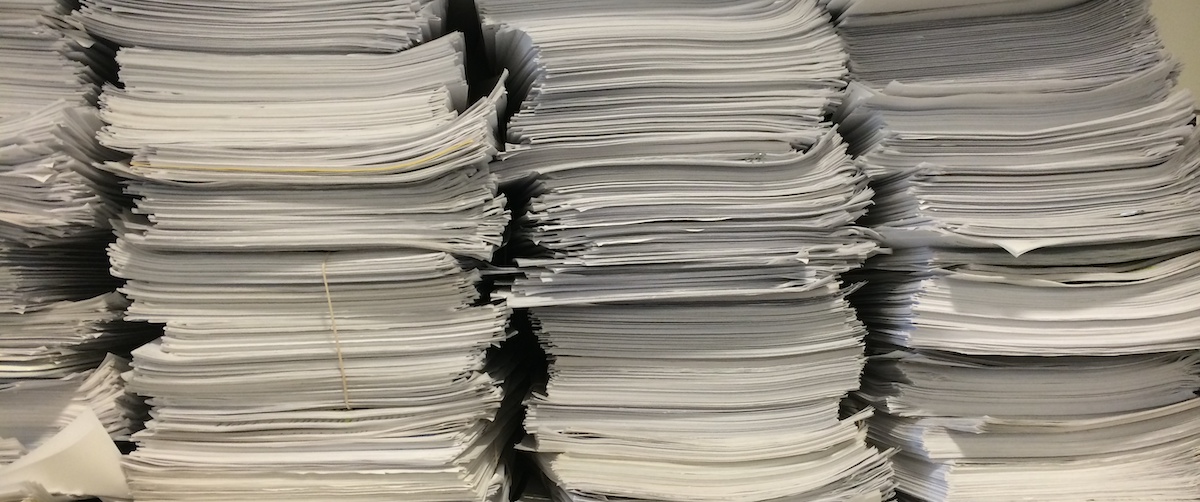
What Does “Longform” Journalism Really Mean?
On love and ruin , terminology, and the anxiety of limits.
Writers are preoccupied with limits: temporal and physical and metaphysical, the divisions between self and other, the mind’s inability to reconstruct the subject of its fascination. Borges envisioned “a Map of the Empire that was of the same Scale as the Empire and that coincided with it point for point.” Moby-Dick ’s Ishmael claimed that “true places” resisted the attempts of mapmakers. Stories often assume the shape of their limitations. In 2006, the same year that Twitter launched, Robert Olen Butler published Severance , a story collection that employed what one reviewer called “a new—and unlikely to be replicated—art form, the vignette of the severed head told in exactly 240 words.”
For journalists, tasked with something like verisimilitude, these limits are always existential. Joe Gould claimed to be writing an oral history whose purview was the knowable world. Joseph Mitchell, who first profiled Gould for The New Yorker in 1942, came to doubt the history’s existence, and said as much after Gould’s death. Gould’s history was never published. Another New Yorker staff writer, Jill Lepore, suspects Gould’s compulsive writing was hypergraphia. “This is an illness, a mania,” she wrote, “but seems more like something a writer might envy.” Perhaps Mitchell did; after his final piece on Gould, Mitchell never published another word. Like Gould’s productivity, Mitchell’s silence was storied but impossible to verify. Lepore wrote about both men in “Joe Gould’s Teeth,” a feature article whose word count grew into a book-length manuscript.
“Writers tumble into this story,” wrote Lepore, “and then they plummet.” The boundaries of the observable world push inward and outward; we are fathomless, the universe immeasurable. Where, then, should a story begin and end?
In the past decade, as declining ad revenue constricted editorial space in print publications, online publishing offered journalists freedom from some of their limits. A story could be as complicated as its subject required, and as long as necessary, though the ancient caveat still applied: your readers might not stick with you until the end. Websites such as BuzzFeed, whose content seemed to assume a newly attention-deficient readership, occasionally published pieces of narrative nonfiction whose word counts reached into the thousands. Online publishers began to label such stories “longform.”
Journalists and their readers have an uneasy history with such labels. “I have no idea who coined the term ‘the New Journalism’ or when it was coined,” wrote Tom Wolfe in a 1972 feature article in New York . “I have never even liked the term.” Neither did Hunter S. Thompson, who wrote to Wolfe and threatened to “have your goddamn femurs ground into bone splinters if you ever mention my name again in connection with that horrible ‘new journalism’ shuck you’re promoting.” (Wolfe still included Thompson in his 1973 anthology, The New Journalism .) “Creative nonfiction” still enjoys wide usage, and a magazine exists by the same name. Its editor, Lee Gutkind, writes that Creative Nonfiction “defines the genre simply, succinctly, and accurately as ‘true stories well told.’” These labels amount to a shaggy taxonomy; journalists that share certain aesthetics are grouped together, and then those groups are differentiated from each other, to the presumed benefit of readers.
Such labels sometimes reward the writer, who becomes associated with a popular movement. They sometimes reward the reader, who has a new word for what she seeks. Most often, they reward the publisher. But a publisher’s loyalties can shift with the market. Medium, a publishing platform that developed an early reputation for longform journalism, distanced itself from the label. (“It was not our intention… to create a platform just for ‘long-form’ content,” said Ev Williams, Medium CEO and a co-founder of Twitter.) BuzzFeed, on the other hand, hired a “longform editor” in 2013 to oversee a section of the site devoted to such stories. The longform editor described his section as “BuzzFeed for people who are afraid of BuzzFeed.”
Whether labels like “longform” reward a story is another matter. “Length is hardly the quality that most meaningfully classifies these stories,” wrote James Bennet in The Atlantic . “Yet there’s a real conundrum here: If ‘long-form’ doesn’t fit, what term is elastic enough to encompass the varied journalism it has come to represent, from narrative to essay, profile to criticism?” The term “journalism” is, somehow, insufficient.
Taxonomy presents one conundrum; popularity makes for another. The “longform” label offers readers and writers a new way to self-identify, and a new hashtag by which they may find, distinguish and promote stories. An attendant risk is that a story’s appeal as a “longform” product could short-circuit editorial judgment and damage a writer or his subject before a large audience.
In 2014, Grantland published “ Dr. V’s Magical Putter ,” a 7,000-word profile of an inventor and transgender woman whose gender transition was revealed in the story—before she had revealed it to people in her life. “What began as a story about a brilliant woman with a new invention,” author Chris Hannan wrote, “had turned into the tale of a troubled man who had invented a new life for himself.” Hannan reveals in his final paragraphs that his subject committed suicide, and wrote, “Writing a eulogy for a person who by all accounts despised you is an odd experience.” In the New York Times , Jonathan Mahler cautioned readers and writers again “fetishizing the form and losing sight of its function.”
“Longform” springs from journalism’s anxiety over limitations—mainly, its online audience’s attention span. During the longform decade, software developers created programs that translate word counts into estimated reading times. Both Longreads.com and Longform.org use the program, as does Medium. For their first assignment, students of the late New York Times media critic David Carr wrote stories with estimated reading times of fewer than five minutes.
In 2011, The Atavist Magazine began to publish longform stories—“one blockbuster nonfiction story a month, generally between 5,000 and 30,000 words.” Since its inception, The Atavist ’s stories have been nominated for eight National Magazine Awards; the magazine’s first win, for 2015’s “Love and Ruin,” was also the first time the coveted “feature writing” award went to a digital magazine. While the magazine’s founder, Evan Ratliff, employs the “longform” label to describe The Atavist ’s work, he doesn’t fret about his audience’s attention span.
“The people who are making decisions based on that, I don’t think they’re doing it based on actual research, either,” he told Columbia Journalism Review a few months after The Atavist Magazine published its first story. “I think they’re all doing it based on anecdotal experience.” Ratliff concluded, “I don’t really care if attention spans are going down in the world overall or not.” And the universe—the unknowable curator of all the components of our stories—doesn’t care either.
Love and Ruin is a new anthology of stories culled from The Atavist ’s first five years. If labels like “longform” mean anything, then Love and Ruin is also the first collection of stories that typify a new genre, a successor to titles like Wolfe’s The New Journalism and Robert Boynton’s The New New Journalism .
“‘Longform’ written storytelling . . . was, it was said, going the way of the black rhino,” Ratliff writes in his foreword. “Our magazine is built on questioning that wisdom.” Still, Ratliff doesn’t dwell on the word; if length can be considered a characteristic of each story in Love and Ruin , then it’s the one that interests him least.
Each story in Love and Ruin first appeared online, via the magazine’s proprietary platform, along with interview excerpts, original photography, embedded videos, and optional audiobook downloads. Most also came with an estimated reading time. The shortest story in Love and Ruin —Brooke Jarvis’ 10,000-word account of the year she spent working with leprosy patients in Kalaupapa, Hawaii, as the community and its last inhabitants dwindled—is classified online as a “44 minute read.” The longest stories clear 20,000 words, which means a time commitment equivalent to watching a feature film.
The ten stories in Love and Ruin fall comfortably within the word counts that The Atavist sets for its nonfiction, a range that contemporary readers expect from “longform.” But word counts and reading times are poor distinguishing features for a genre, a lackluster explanation for why these stories should appear together, and a useless tool for evaluating the rewards of the book.
The stories in Love and Ruin don’t share many sensibilities. Ratliff writes in his foreword that there is no “house style”—a suggestion that each Atavist story is told in something closer to each writer’s authentic voice. In her introduction, New Yorker staff writer Susan Orlean takes on journalism’s taxonomy problem, sets aside a few genre labels (“new journalism,” “creative nonfiction,” “longform”), and then classifies the stories in Love and Ruin as “magpie journalism.” It’s a laudatory phrase, but at a second glance it doesn’t distinguish the stories in Love and Ruin from plenty of others.
If the stories in Love and Ruin are bound by something other than glue, then it’s a sort of thematic unity, born from the same anxieties that gave us “longform.” Each story in Love and Ruin depicts its author’s struggle with the limits of investigation, representation, or understanding. “The Fort of Young Saplings” follows Vanessa Veselka’s tangential connection to a native Alaskan tribe back to the moment when that tribe’s history was overwritten. Jarvis’ story, “When We Are Called to Part,” approaches the same critical moment, when a community becomes a collection of stories, told selectively and bracketed by time. In “Mother, Stranger,” Cris Beam navigates the fog of her abusive mother’s mental illness and her own traumatic upbringing. “I didn’t have a language for my mother,” writes Beam, “probably because she didn’t have a cohesive language for herself.” The black boxes in Love and Ruin are figurative and sometimes literal; Adam Higginbotham’s “1,000 Pounds of Dynamite,” an anatomy of a failed extortion plot, features both.
Underpinned by limits and all their attendant complications, the narratives that arise from Love and Ruin are fundamentally strange and unwieldy, and as long as they need to be. Leslie Jamison’s “52 Blue” provides Love and Ruin with its most luminous prose. But the story—about a solitary whale that sings at a unique and isolating frequency, and the people drawn to the whale’s story—also offers the anthology’s best consideration of the boundaries that shape stories and their telling.
“52 Blue suggests not just one single whale as a metaphor for loneliness, but metaphor itself as a salve for loneliness,” Jamison writes. “What if we grant the whale his whaleness, grant him furlough from our metaphoric employ, but still grant the contours of his second self—the one we’ve made—and admit what he’s done for us?”
Jamison does not reach her best ideas in few words. But without the words she uses, those ideas may not be otherwise reachable. A story’s word count can sometimes be a proxy for complexity; that’s the appeal of a label like “longform” for the readers that claim to love it. But complicated stories also refute “longform.” They leave their readers with a feeling that the story and its shape are an inevitable match. How else could it have been told?
Here, then, is The Atavist ’s chief achievement with Love and Ruin : In collecting its finest “longform” nonfiction, The Atavist created an anthology that undermines its own flimsy label—and, hopefully, refutes some of our anxiety about time and attention, and the other limits that govern our lives.
The anxiety of limitation—the dread of meaning lost, to time and to space—is recurrent. “Before there were even screens in our living rooms, the same worries reared their heads,” writes Nick Bilton in I Live in the Future, and Here’s How it Works . “There was a time in the 1920s when cultural critics feared Americans were losing their ability to swallow a long, thoughtful novel or even a detailed magazine piece. The evil culprit: Reader’s Digest .”
But the condensed and excerpted stories in Reader’s Digest didn’t bring about the end of attention, or of complicated storytelling. “Reader’s weren’t abandoning long stories for short ones,” writes Bilton. “The appeal of Reader’s Digest was in the overall experience.”
In 2001, David Foster Wallace—who died in the early years of the “longform” decade and whose nonfiction posthumously bears that label—reviewed a collection of prose poems. “These putatively ‘transgressive’ forms depend heavily on received ideas of genre, category, and formal conventions,” wrote Wallace, “since without such an established context there’s nothing much to transgress against.” Do away with some of those conventions and received ideas, and a genre seems more accommodating. Labels like “longform” and “prose poem” are unnecessary limitations; they may evoke a certain shape, but they also constrain it.
A few years ago, for his introduction to The Best American Magazine Writing , James Bennet wrote a short essay that later appeared online at The Atlantic , under the headline “Against ‘Long-Form Journalism.’” Bennet argues that the label is insubstantial and misleading, and then suggests “another perfectly good, honorable name for this kind of work—the one on the cover of this anthology. You might just call it all magazine writing.” But that’s like distinguishing between “book fiction” and “movie fiction,” and besides, “magazine journalism” conflates a story with a product. A medium like print may help to shape a story, but that medium is always just a tool in the service of a narrative, and media change. There will come a time when Best American Magazine Writing needs a new title.
All the stories we tell are products of limits. Time shatters histories and then hides a few pieces. Writers construct narratives and, inevitably, omit some details. Addressing the same issue in photography, Errol Morris asked, “Isn’t there always a possible elephant lurking just at the edge of the frame?” Perhaps the elephant is unimportant to the story. And yet, there he is.
Here’s the trade-off: Narratives require that we surrender our conceptions of time and space, that we readjust our ideas of what can be known and what might be said. They can be fallible by design but still leave understanding in their wake. A story, of any length, moves readers through the world without fracturing meaning. The world fractures meaning on its own.
So perhaps we can unburden ourselves of labels like “longform.” The Atavist has already begun to do just that; in 2014, the site stopped translating word counts into estimated reading times. And perhaps we can task ourselves with something more: that we read and write closer to those circumstances that bracket our lives, and simply take the time and space we need.
- Share on Facebook (Opens in new window)
- Click to share on Twitter (Opens in new window)
- Click to share on Google+ (Opens in new window)
- Click to share on LinkedIn (Opens in new window)
- Click to share on Reddit (Opens in new window)
- Click to share on Tumblr (Opens in new window)
- Click to share on Pinterest (Opens in new window)
- Click to share on Pocket (Opens in new window)
Brendan Fitzgerald
Previous article, next article, support lit hub..

Join our community of readers.
to the Lithub Daily
Popular posts.

Follow us on Twitter
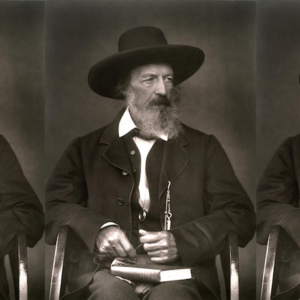
Best of the Week: November 14 - 18, 2016
- RSS - Posts
Literary Hub
Created by Grove Atlantic and Electric Literature
Sign Up For Our Newsletters
How to Pitch Lit Hub
Advertisers: Contact Us
Privacy Policy
Support Lit Hub - Become A Member
Become a Lit Hub Supporting Member : Because Books Matter
For the past decade, Literary Hub has brought you the best of the book world for free—no paywall. But our future relies on you. In return for a donation, you’ll get an ad-free reading experience , exclusive editors’ picks, book giveaways, and our coveted Joan Didion Lit Hub tote bag . Most importantly, you’ll keep independent book coverage alive and thriving on the internet.

Become a member for as low as $5/month

A (very long) essay on political communications, French style
19 October 2011
Posted by Alastair Campbell
18 minute(s) read
Recent Posts

A tale of two spy chiefs, and their views on past, present and future
31 March 2024

Into the Lions’ Den of private education … to a friendlier reception than I expected
8 February 2024

Politics – far too important to be left to the grown-ups!
5 February 2024

Margaret Thatcher would send Jenrick packing PDQ
17 January 2024
9 responses to “A (very long) essay on political communications, French style”
The ego has landed.
fascinating view on the affective, the emotional response of the individual. Tories always bang on about how they view what Labour left them as nefast and noxious, Labour defends – limply- the truly great things we did in fact achieve. The above text would clearly show both miss the point. On vote pour le futur. Pas pour le passe The presidential focus of this text – On vote pour un homme. Pas pour un parti- may jar greatly with many in this country. T.B was viewed as too much this way by many.
Another masochist ? It’s truly weird.
The emergence of social media is an interesting development and may, in time, alter the political dynamic. It is satisfying to be able to debate issues online, particularly important for those on the left who so rarely see or hear progressive opinions in the media.
Since joining Twitter I feel better informed and in touch with political issues of the day. Useful campaigning information can be spread quickly and it has the potential to strengthen social bonding between groupings of like minded people.
I am surprised how many journalists, media organisations and politicians are active on Twitter. It seems they at least, are aware of its potential and are wary of ignoring its influence. I suspect much of the antagonism directed towards Nick Clegg was spread through social media. Tenagers don’t generally read newspapers or watch TV news, but they do talk to each other via Facebook.
Let’s hope it will make a difference. Since the collapse of widescale union membership, too many natural Labour supporters don’t hear our political message. Most probably read right wing papers and watch Sky TV. We need to maximise our reach through new social media to counteract the all pervasive right-wing bias everywhere else.
Norway is an amazing modern country, and how it has used it’s oil and natural resouces for the best of all its people should be a set lesson to any country in the World. Efficiency in it’s extraction, and efficiency in using its resulting wealth. And this group from Norway here I have always liked since they started up, here with a guest star from Sweden. Royksopp and Robyn, http://www.youtube.com/watch?v=SfckrfOYAy4
And well done for having respect from La France, but that personally does not surprise me. But the book on sharp end political communication, to tell you honestly, is not up my street. I am into other things in life, you might have noticed.
Anyway, Alastair, isn’t it about time you thought of becoming an MP? Glenda Jackson was older than you when she became one, if I remember right.
Ah yes, just checked, she was about 56, while you are only, ahem!, 54, but without a couple of oscars…
you total wanks. I know who you are and everything. You are pathetic in trying to be higher. Higher than what, you tell we banging keyboard in your own worlds. Need a keyboard to grow vegetibles? Don’t think so somehow.
Time, ey? Who’ll have it? Raised with praise to die? Parentals withering before eyes, heartbreaking before yourself die.
Life, who’ll have it? asked? Not by many with sense. To see life’s gymnastics performed, buck over a horse yes or no the normed.
More scandanavian, with a 23 windowed VW german Samba minibus, and red riding hood, yes, her and her subliminal hidden story, Grimm from Copenhagen-like, http://www.youtube.com/watch?v=Y54ABqSOScQ
Saw Clarissa Dickson show today – brilliant! Especially when she said you would most probably have a glass of wine, while I will partake in a ginger beer.
Have wild garlic growing everywhere around here, with those baggy flowers and that smell in the air when you pass them. Will have to note them so to dig the bulbs when ready. Gawd knows what garlic strain they be though.
Leave a Reply Cancel reply
Your email address will not be published. Required fields are marked *
Save my name, email, and website in this browser for the next time I comment.

67. A Tale of Two Spies: The former heads of MI5 and MI6 on the Iraq War, double agents, and the IRA
1 April 2024

232. Question Time: ISIS-K vs Russia, radical reform of the NHS, and the fight against child poverty
28 March 2024
231. Labour’s struggle for economic vision and Haiti on the brink
27 March 2024
66. Antony Gormley: Art, religion, and the battle for culture
25 March 2024
230. Question Time: £91,000… Should MPs be paid more?
21 March 2024
229. Putin’s sham election, Sunak under threat, and the rift between France and Germany
20 March 2024

Alastair Campbell’s Diary: Keir Starmer is better suited to government than opposition

By the BOOK
Morgan Parker Says ‘Poetry Is Under Everything’ She Writes
Crafting the arguments in “You Get What You Pay For,” her first essay collection, “felt like pulling apart a long piece of taffy,” says the author of “Magical Negro.”
Credit... Rebecca Clarke
Supported by
- Share full article
What books are on your night stand?
The craft anthology “How We Do It,” edited by the great Jericho Brown, and Shayla Lawson’s astounding “How to Live Free in a Dangerous World.”
Describe your ideal reading experience (when, where, what, how).
Probably on the smoking patio of a wine bar at happy hour on a sunny day, with a pencil in my hand and Dorothy Ashby or Ambrose Akinmusire playing through noise-canceling headphones. Or just a quiet morning on my couch with coffee, so engrossed I forget to flip the record.
What’s the last book you read that made you laugh?
“Erasure,” by Percival Everett . I picked up a used copy at Shakespeare & Company recently — after seeing Cord Jefferson’s brilliant adaptation , “American Fiction” — and even on a reread, it made me laugh out loud from the first page.
The last book that made you cry?
Weird or obnoxious if I say my own? Before that, it was probably Y.A.
Do you count any books as guilty pleasures?
That category’s filled to the brim and beyond by reality TV.
How do you organize your books?
Loosely or not at all. This is much to the horror of my Virgo pals, and while I used to take pride in navigating my shelves on familiarity alone, it’s something I’ve vowed to work on. Still, I doubt I’ll ever be an alphabetical type, and clearly I find genre segregation constricting. I do group things thematically, or even interpersonally — music biographies, Black Panthers, Harlem Renaissance; Jessica Hopper is next to John Giorno, and Chase Berggrun’s “R E D” is next to “Dracula”; Julie Buntin’s “Marlena” is beside her husband Gabe Habash’s “Stephen Florida”; Alison C. Rollins is next to her partner Nate Marshall is next to his bestie José Olivarez. At some point Hilton Als’s “White Girls” ended up next to “Male Fantasies,” and I don’t think I’ll ever separate them.
Which genres do you avoid?
There’s an essay in “You Get What You Pay For” where I mention reading a self-help book (as recommended by my now-former psychiatrist). I’d never read one before and have not since.
How does your poetry relate to your essay writing?
The truth is that poetry is under everything. It’s the lyric and sensory backbone. It’s what drives the sound, pace and imagery. (Everyone knows the best prose writers write and read poetry.) But while a poem strives for precision of language, the essay strives for precision of thought, even argument. In a poem, you can build (or approximate) an argument by plopping two images next to each other. It persuades by pointing. Writing these essays felt like pulling apart a long piece of taffy — I found myself reiterating a lot of what I’ve already expressed in poems, so it almost became a project of stretching out each poetic line, breaking down each concept to its root. The process is about asking, pondering, searching — and letting language take part in the answering.
You have a knack for terrific book titles. How did you name your new collection?
Thank you! I love a good title, but I also acknowledge the high bar I have set for myself. With this one, I struggled a bit, I think because it took me a while to understand the book myself, let alone how to introduce it to the world. The essays encompass a lot of seemingly disparate themes and even tonal registers, so framing the overall collection was daunting. I’d been tossing around a couple of options, including “Cheaper Than Therapy,” which appears as an essay title, when Jay-Z made the choice for me. I was in Italy at a residency, grieving the recent loss of my aunt and watching the “Big Pimpin’” video over and over as I worked on an essay about it for the book. I’d left my heavily tabbed copy of “Decoded” at home in Los Angeles, but was scrolling a PDF for details about the video shoot when I came across the line: “If the price is life, then you better get what you paid for.”
You describe yourself as foolish for believing “words could be the pathway to empathy and writing an active resistance against hate.” Might publishing this book change your mind?
Honestly? It’s my only hope.
What’s the last book you recommended to a member of your family?
“Heavy,” by Kiese Laymon, to my mom; Blair LM Kelley’s “ Black Folk: The Roots of the Black Working Class,” to my dad; and “A Is for Activist,” to my 8-month-old cousin.
What do you plan to read next?
Phillip B. Williams’s “Ours” was just published, and I’ve been excited about it for literally years. Vinson Cunningham’s “Great Expectations” came out the same day as my book, so I plan to make that my tour read.
You’re organizing a literary dinner party. Which three writers, dead or alive, do you invite?
June Jordan, Zora Neale Hurston, James Baldwin — but I’d be lying if I said I wouldn’t get just as much fun and fulfillment from a night with Angel Nafis, Danez Smith and Saeed Jones.
Explore More in Books
Want to know about the best books to read and the latest news start here..
James McBride’s novel sold a million copies, and he isn’t sure how he feels about that, as he considers the critical and commercial success of “The Heaven & Earth Grocery Store.”
How did gender become a scary word? Judith Butler, the theorist who got us talking about the subject , has answers.
You never know what’s going to go wrong in these graphic novels, where Circus tigers, giant spiders, shifting borders and motherhood all threaten to end life as we know it .
When the author Tommy Orange received an impassioned email from a teacher in the Bronx, he dropped everything to visit the students who inspired it.
Do you want to be a better reader? Here’s some helpful advice to show you how to get the most out of your literary endeavor .
Each week, top authors and critics join the Book Review’s podcast to talk about the latest news in the literary world. Listen here .
Advertisement
Things you buy through our links may earn Vox Media a commission.
Andrew Huberman’s Mechanisms of Control
The private and public seductions of the world’s biggest pop neuroscientist..
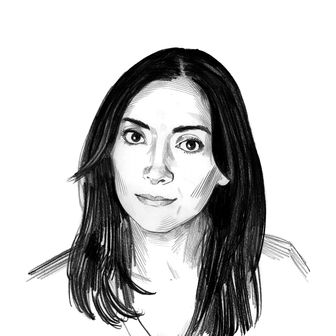
This article was featured in One Great Story , New York ’s reading recommendation newsletter. Sign up here to get it nightly.
For the past three years, one of the biggest podcasters on the planet has told a story to millions of listeners across half a dozen shows: There was a little boy, and the boy’s family was happy, until one day, the boy’s family fell apart. The boy was sent away. He foundered, he found therapy, he found science, he found exercise. And he became strong.
Today, Andrew Huberman is a stiff, jacked 48-year-old associate professor of neurology and ophthalmology at the Stanford University School of Medicine. He is given to delivering three-hour lectures on subjects such as “the health of our dopaminergic neurons.” His podcast is revelatory largely because it does not condescend, which has not been the way of public-health information in our time. He does not give the impression of someone diluting science to universally applicable sound bites for the slobbering masses. “Dopamine is vomited out into the synapse or it’s released volumetrically, but then it has to bind someplace and trigger those G-protein-coupled receptors, and caffeine increases the number, the density of those G-protein-coupled receptors,” is how he explains the effect of coffee before exercise in a two-hour-and-16-minute deep dive that has, as of this writing, nearly 8.9 million views on YouTube.
In This Issue
Falling for dr. huberman.
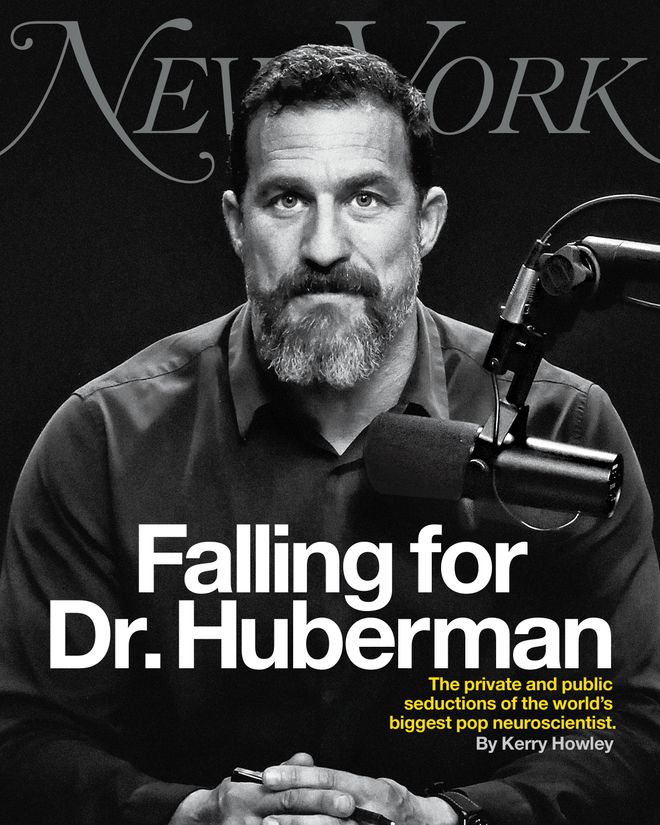
Millions of people feel compelled to hear him draw distinctions between neuromodulators and classical neurotransmitters. Many of those people will then adopt an associated “protocol.” They will follow his elaborate morning routine. They will model the most basic functions of human life — sleeping, eating, seeing — on his sober advice. They will tell their friends to do the same. “He’s not like other bro podcasters,” they will say, and they will be correct; he is a tenured Stanford professor associated with a Stanford lab; he knows the difference between a neuromodulator and a neurotransmitter. He is just back from a sold-out tour in Australia, where he filled the Sydney Opera House. Stanford, at one point, hung signs (AUTHORIZED PERSONNEL ONLY) apparently to deter fans in search of the lab.
With this power comes the power to lift other scientists out of their narrow silos and turn them, too, into celebrities, but these scientists will not be Huberman, whose personal appeal is distinct. Here we have a broad-minded professor puppyishly enamored with the wonders of biological function, generous to interviewees (“I love to be wrong”), engaged in endearing attempts to sound like a normal person (“Now, we all have to eat, and it’s nice to eat foods that we enjoy. I certainly do that. I love food, in fact”).
This is a world in which the soft art of self-care is made concrete, in which Goop-adjacent platitudes find solidity in peer review. “People go, ‘Oh, that feels kind of like weenie stuff,’” Huberman tells Joe Rogan. “The data show that gratitude, and avoiding toxic people and focusing on good-quality social interactions … huge increases in serotonin.” “Hmmm,” Rogan says. There is a kindness to the way Huberman reminds his audience always of the possibilities of neuroplasticity: They can change. He has changed. As an adolescent, he says, he endured the difficult divorce of his parents, a Stanford professor who worked in the tech industry and a children’s-book author. The period after the separation was, he says, one of “pure neglect.” His father was gone, his mother “totally checked out.” He was forced, around age 14, to endure a month of “youth detention,” a situation that was “not a jail,” but harrowing in its own right.
“The thing that really saved me,” Huberman tells Peter Attia, “was this therapy thing … I was like, Oh, shit … I do have to choke back a little bit here. It’s a crazy thing to have somebody say, ‘Listen,’ like, to give you the confidence, like, ‘We’re gonna figure this out. We’re gonna figure this out. ’ There’s something very powerful about that. It wasn’t like, you know, ‘Everything will be okay.’ It was like, We’re gonna figure this out. ”
The wayward son would devote himself to therapy and also to science. He would turn Rancid all the way up and study all night long. He would be tenured at Stanford with his own lab, severing optic nerves in mice and noting what grew back.
Huberman has been in therapy, he says, since high school. He has, in fact, several therapists, and psychiatrist Paul Conti appears on his podcast frequently to discuss mental health. Therapy is “hard work … like going to the gym and doing an effective workout.” The brain is a machine that needs tending. Our cells will benefit from the careful management of stress. “I love mechanism, ” says Huberman; our feelings are integral to the apparatus. There are Huberman Husbands (men who optimize), a phenomenon not to be confused with #DaddyHuberman (used by women on TikTok in the man’s thrall).
A prophet must constrain his self-revelation. He must give his story a shape that ultimately tends toward inner strength, weakness overcome. For Andrew Huberman to become your teacher and mine, as he very much was for a period this fall — a period in which I diligently absorbed sun upon waking, drank no more than once a week, practiced physiological sighs in traffic, and said to myself, out loud in my living room, “I also love mechanism”; a period during which I began to think seriously, for the first time in my life, about reducing stress, and during which both my husband and my young child saw tangible benefit from repeatedly immersing themselves in frigid water; a period in which I realized that I not only liked this podcast but liked other women who liked this podcast — he must be, in some way, better than the rest of us.
Huberman sells a dream of control down to the cellular level. But something has gone wrong. In the midst of immense fame, a chasm has opened between the podcaster preaching dopaminergic restraint and a man, with newfound wealth, with access to a world unseen by most professors. The problem with a man always working on himself is that he may also be working on you.
Some of Andrew’s earliest Instagram posts are of his lab. We see smiling undergraduates “slicing, staining, and prepping brains” and a wall of framed science publications in which Huberman-authored papers appear: Nature, Cell Reports, The Journal of Neuroscience. In 2019, under the handle @hubermanlab, Andrew began posting straightforward educational videos in which he talks directly into the camera about subjects such as the organizational logic of the brain stem. Sometimes he would talk over a simple anatomical sketch on lined paper; the impression was, as it is now, of a fast-talking teacher in conversation with an intelligent student. The videos amassed a fan base, and Andrew was, in 2020, invited on some of the biggest podcasts in the world. On Lex Fridman Podcast, he talked about experiments his lab was conducting by inducing fear in people. On The Rich Roll Podcast, the relationship between breathing and motivation. On The Joe Rogan Experience, experiments his lab was conducting on mice.
He was a fluid, engaging conversationalist, rich with insight and informed advice. In a year of death and disease, when many felt a sense of agency slipping away, Huberman had a gentle plan. The subtext was always the same: We may live in chaos, but there are mechanisms of control.
By then he had a partner, Sarah, which is not her real name. Sarah was someone who could talk to anyone about anything. She was dewy and strong and in her mid-40s, though she looked a decade younger, with two small kids from a previous relationship. She had old friends who adored her and no trouble making new ones. She came across as scattered in the way she jumped readily from topic to topic in conversation, losing the thread before returning to it, but she was in fact extremely organized. She was a woman who kept track of things. She was an entrepreneur who could organize a meeting, a skill she would need later for reasons she could not possibly have predicted. When I asked her a question in her home recently, she said the answer would be on an old phone; she stood up, left for only a moment, and returned with a box labeled OLD PHONES.
Sarah’s relationship with Andrew began in February 2018 in the Bay Area, where they both lived. He messaged her on Instagram and said he owned a home in Piedmont, a wealthy city separate from Oakland. That turned out not to be precisely true; he lived off Piedmont Avenue, which was in Oakland. He was courtly and a bit formal, as he would later be on the podcast. In July, in her garden, Sarah says she asked to clarify the depth of their relationship. They decided, she says, to be exclusive.
Both had devoted their lives to healthy living: exercise, good food, good information. They cared immoderately about what went into their bodies. Andrew could command a room and clearly took pleasure in doing so. He was busy and handsome, healthy and extremely ambitious. He gave the impression of working on himself; throughout their relationship, he would talk about “repair” and “healthy merging.” He was devoted to his bullmastiff, Costello, whom he worried over constantly: Was Costello comfortable? Sleeping properly? Andrew liked to dote on the dog, she says, and he liked to be doted on by Sarah. “I was never sitting around him,” she says. She cooked for him and felt glad when he relished what she had made. Sarah was willing to have unprotected sex because she believed they were monogamous.
On Thanksgiving in 2018, Sarah planned to introduce Andrew to her parents and close friends. She was cooking. Andrew texted repeatedly to say he would be late, then later. According to a friend, “he was just, ‘Oh yeah, I’ll be there. Oh, I’m going to be running hours late.’ And then of course, all of these things were planned around his arrival and he just kept going, ‘Oh, I’m going to be late.’ And then it’s the end of the night and he’s like, ‘Oh, I’m so sorry this and this happened.’”
Huberman disappearing was something of a pattern. Friends, girlfriends, and colleagues describe him as hard to reach. The list of reasons for not showing up included a book, time-stamping the podcast, Costello, wildfires, and a “meetings tunnel.” “He is flaky and doesn’t respond to things,” says his friend Brian MacKenzie, a health influencer who has collaborated with him on breathing protocols. “And if you can’t handle that, Andrew definitely is not somebody you want to be close to.” “He in some ways disappeared,” says David Spiegel, a Stanford psychiatrist who calls Andrew “prodigiously smart” and “intensely engaging.” “I mean, I recently got a really nice email from him. Which I was touched by. I really was.”
In 2018, before he was famous, Huberman invited a Colorado-based investigative journalist and anthropologist, Scott Carney, to his home in Oakland for a few days; the two would go camping and discuss their mutual interest in actionable science. It had been Huberman, a fan of Carney’s book What Doesn’t Kill Us, who initially reached out, and the two became friendly over phone and email. Huberman confirmed Carney’s list of camping gear: sleeping bag, bug spray, boots.
When Carney got there, the two did not go camping. Huberman simply disappeared for most of a day and a half while Carney stayed home with Costello. He puttered around Huberman’s place, buying a juice, walking through the neighborhood, waiting for him to return. “It was extremely weird,” says Carney. Huberman texted from elsewhere saying he was busy working on a grant. (A spokesperson for Huberman says he clearly communicated to Carney that he went to work.) Eventually, instead of camping, the two went on a few short hikes.
Even when physically present, Huberman can be hard to track. “I don’t have total fidelity to who Andrew is,” says his friend Patrick Dossett. “There’s always a little unknown there.” He describes Andrew as an “amazing thought partner” with “almost total recall,” such a memory that one feels the need to watch what one says; a stray comment could surface three years later. And yet, at other times, “you’re like, All right, I’m saying words and he’s nodding or he is responding, but I can tell something I said sent him down a path that he’s continuing to have internal dialogue about, and I need to wait for him to come back. ”
Andrew Huberman declined to be interviewed for this story. Through a spokesman, Huberman says he did not become exclusive with Sarah until late 2021, that he was not doted on, that tasks between him and Sarah were shared “based on mutual agreement and proficiency,” that their Thanksgiving plans were tentative, and that he “maintains a very busy schedule and shows up to the vast majority of his commitments.”
In the fall of 2020, Huberman sold his home in Oakland and rented one in Topanga, a wooded canyon enclave contiguous with Los Angeles. When he came back to Stanford, he stayed with Sarah, and when he was in Topanga, Sarah was often with him.
When they fought, it was, she says, typically because Andrew would fixate on her past choices: the men she had been with before him, the two children she had had with another man. “I experienced his rage,” Sarah recalls, “as two to three days of yelling in a row. When he was in this state, he would go on until 11 or 12 at night and sometimes start again at two or three in the morning.”
The relationship struck Sarah’s friends as odd. At one point, Sarah said, “I just want to be with my kids and cook for my man.” “I was like, Who says that? ” says a close friend. “I mean, I’ve known her for 30 years. She’s a powerful, decisive, strong woman. We grew up in this very feminist community. That’s not a thing either of us would ever say.”
Another friend found him stressful to be around. “I try to be open-minded,” she said of the relationship. “I don’t want to be the most negative, nonsupportive friend just because of my personal observations and disgust over somebody.” When they were together, he was buzzing, anxious. “He’s like, ‘Oh, my dog needs his blanket this way.’ And I’m like, ‘Your dog is just laying there and super-cozy. Why are you being weird about the blanket?’”
Sarah was not the only person who experienced the extent of Andrew’s anger. In 2019, Carney sent Huberman materials from his then-forthcoming book, The Wedge, in which Huberman appears. He asked Huberman to confirm the parts in which he was mentioned. For months, Huberman did not respond. Carney sent a follow-up email; if Huberman did not respond, he would assume everything was accurate. In 2020, after months of saying he was too busy to review the materials, Huberman called him and, Carney says, came at him in a rage. “I’ve never had a source I thought was friendly go bananas,” says Carney. Screaming, Huberman threatened to sue and accused Carney of “violating Navy OpSec.”
It had become, by then, one of the most perplexing relationships of Carney’s life. That year, Carney agreed to Huberman’s invitation to swim with sharks on an island off Mexico. First, Carney would have to spend a month of his summer getting certified in Denver. He did, at considerable expense. Huberman then canceled the trip a day before they were set to leave. “I think Andrew likes building up people’s expectations,” says Carney, “and then he actually enjoys the opportunity to pull the rug out from under you.”
In January 2021, Huberman launched his own podcast. Its reputation would be directly tied to his role as teacher and scientist. “I’d like to emphasize that this podcast,” he would say every episode, with his particular combination of formality and discursiveness, “is separate from my teaching and research roles at Stanford. It is, however, part of my desire and effort to bring zero-cost-to-consumer information about science and science-related tools to the general public.”
“I remember feeling quite lonely and making some efforts to repair that,” Huberman would say on an episode in 2024. “Loneliness,” his interviewee said, “is a need state.” In 2021, the country was in the later stages of a need state: bored, alone, powerless. Huberman offered not only hours of educative listening but a plan to structure your day. A plan for waking. For eating. For exercising. For sleep. At a time when life had shifted to screens, he brought people back to their corporeal selves. He advised a “physiological sigh” — two short breaths in and a long one out — to reduce stress. He pulled countless people from their laptops and put them in rhythm with the sun. “Thank you for all you do to better humanity,” read comments on YouTube. “You may have just saved my life man.” “If Andrew were science teacher for everyone in the world,” someone wrote, “no one would have missed even a single class.”
Asked by Time last year for his definition of fun, Huberman said, “I learn and I like to exercise.” Among his most famous episodes is one in which he declares moderate drinking decidedly unhealthy. As MacKenzie puts it, “I don’t think anybody or anything, including Prohibition, has ever made more people think about alcohol than Andrew Huberman.” While he claims repeatedly that he doesn’t want to “demonize alcohol,” he fails to mask his obvious disapproval of anyone who consumes alcohol in any quantity. He follows a time-restricted eating schedule. He discusses constraint even in joy, because a dopamine spike is invariably followed by a drop below baseline; he explains how even a small pleasure like a cup of coffee before every workout reduces the capacity to release dopamine. Huberman frequently refers to the importance of “social contact” and “peace, contentment, and delight,” always mentioned as a triad; these are ultimately leveraged for the one value consistently espoused: physiological health.
In August 2021, Sarah says she read Andrew’s journal and discovered a reference to cheating. She was, she says, “gutted.” “I hear you are saying you are angry and hurt,” he texted her the same day. “I will hear you as much as long as needed for us.”
Andrew and Sarah wanted children together. Optimizers sometimes prefer not to conceive naturally; one can exert more control when procreation involves a lab. Sarah began the first of several rounds of IVF. (A spokesperson for Huberman denies that he and Sarah had decided to have children together, clarifying that they “decided to create embryos by IVF.”)
In 2021, she tested positive for a high-risk form of HPV, one of the variants linked to cervical cancer. “I had never tested positive,” she says, “and had been tested regularly for ten years.” (A spokesperson for Huberman says he has never tested positive for HPV. According to the CDC, there is currently no approved test for HPV in men.) When she brought it up, she says, he told her you could contract HPV from many things.
“I’d be remiss if I didn’t ask about truth-telling and deception,” Andrew told evolutionary psychologist David Buss on a November 2021 episode of Huberman Lab called “How Humans Select & Keep Romantic Partners in Short & Long Term.” They were talking about regularities across cultures in mate preferences.
“Could you tell us,” Andrew asked, “about how men and women leverage deception versus truth-telling and communicating some of the things around mate choice selection?”
“Effective tactics for men,” said a gravel-voiced, 68-year-old Buss, “are often displaying cues to long-term interest … men tend to exaggerate the depths of their feelings for a woman.”
“Let’s talk about infidelity in committed relationships,” Andrew said, laughing. “I’m guessing it does happen.”
“Men who have affairs tend to have affairs with a larger number of affair partners,” said Buss. “And so which then by definition can’t be long-lasting. You can’t,” added Buss wryly, “have the long-term affairs with six different partners.”
“Yeah,” said Andrew, “unless he’s, um,” and here Andrew looked into the distance. “Juggling multiple, uh, phone accounts or something of that sort.”
“Right, right, right, and some men try to do that, but I think it could be very taxing,” said Buss.
By 2022, Andrew was legitimately famous. Typical headlines read “I tried a Stanford professor’s top productivity routine” and “Google CEO Uses ‘Nonsleep Deep Rest’ to Relax.” Reese Witherspoon told the world that she was sure to get ten minutes of sunlight in the morning and tagged Andrew. When he was not on his own podcast, Andrew was on someone else’s. He kept the place in Topanga, but he and Sarah began splitting rent in Berkeley. In June 2022, they fully combined lives; Sarah relocated her family to Malibu to be with him.
According to Sarah, Andrew’s rage intensified with cohabitation. He fixated on her decision to have children with another man. She says he told her that being with her was like “bobbing for apples in feces.” “The pattern of your 11 years, while rooted in subconscious drives,” he told her in December 2021, “creates a nearly impossible set of hurdles for us … You have to change.”
Sarah was, in fact, changing. She felt herself getting smaller, constantly appeasing. She apologized, again and again and again. “I have been selfish, childish, and confused,” she said. “As a result, I need your protection.” A spokesperson for Huberman denies Sarah’s accounts of their fights, denies that his rage intensified with cohabitation, denies that he fixated on Sarah’s decision to have children with another man, and denies that he said being with her was like bobbing for apples in feces. A spokesperson said, “Dr. Huberman is very much in control of his emotions.”
The first three rounds of IVF did not produce healthy embryos. In the spring of 2022, enraged again about her past, Andrew asked Sarah to explain in detail what he called her bad choices, most especially having her second child. She wrote it out and read it aloud to him. A spokesperson for Huberman denies this incident and says he does not regard her having a second child as a bad choice.
I think it’s important to recognize that we might have a model of who someone is,” says Dossett, “or a model of how someone should conduct themselves. And if they do something that is out of sync with that model, it’s like, well, that might not necessarily be on that person. Maybe it’s on us. Our model was just off.”
Huberman’s specialty lies in a narrow field: visual-system wiring. How comfortable one feels with the science propagated on Huberman Lab depends entirely on how much leeway one is willing to give a man who expounds for multiple hours a week on subjects well outside his area of expertise. His detractors note that Huberman extrapolates wildly from limited animal studies, posits certainty where there is ambiguity, and stumbles when he veers too far from his narrow realm of study, but even they will tend to admit that the podcast is an expansive, free (or, as he puts it, “zero-cost”) compendium of human knowledge. There are quack guests, but these are greatly outnumbered by profound, complex, patient, and often moving descriptions of biological process.
Huberman Lab is premised on the image of a working scientist. One imagines clean white counters, rodents in cages, postdocs peering into microscopes. “As scientists,” Huberman says frequently. He speaks often, too, of the importance of mentorship. He “loves” reading teacher evaluations. On the web, one can visit the lab and even donate. I have never met a Huberman listener who doubted the existence of such a place, and this appears to be by design. In a glowing 2023 profile in Stanford magazine, we learn “Everything he does is inspired by this love,” but do not learn that Huberman lives 350 miles and a six-hour drive from Stanford University, making it difficult to drop into the lab. Compounding the issue is the fact that the lab, according to knowledgeable sources, barely exists.
“Is a postdoc working on her own funding, alone, a ‘lab?’” asks a researcher at Stanford. There had been a lab — four rooms on the second floor of the Sherman Fairchild Science Building. Some of them smelled of mice. It was here that researchers anesthetized rodents, injected them with fluorescence, damaged their optic nerves, and watched for the newly bright nerves to grow back.
The lab, says the researcher, was already scaling down before COVID. It was emptying out, postdocs apparently unsupervised, a quarter-million-dollar laser-scanning microscope gathering dust. Once the researcher saw someone come in and reclaim a $3,500 rocker, a machine for mixing solutions.
Shortly before publication, a spokesperson for Stanford said, “Dr. Huberman’s lab at Stanford is operational and is in the process of moving from the Department of Neurobiology to the Department of Ophthalmology,” and a spokesperson for Huberman says the equipment in Dr. Huberman’s lab remained in use until the last postdoc moved to a faculty position.
On every episode of his “zero-cost” podcast, Huberman gives a lengthy endorsement of a powder formerly known as Athletic Greens and now as AG1. It is one thing to hear Athletic Greens promoted by Joe Rogan; it is perhaps another to hear someone who sells himself as a Stanford University scientist just back from the lab proclaim that this $79-a-month powder “covers all of your foundational nutritional needs.” In an industry not noted for its integrity, AG1 is, according to writer and professional debunker Derek Beres, “one of the most egregious players in the space.” Here we have a powder that contains, according to its own marketing, 75 active ingredients, far more than the typical supplement, which would seem a selling point but for the inconveniences of mass. As performance nutritionist Adam McDonald points out, the vast number of ingredients indicates that each ingredient, which may or may not promote good health in a certain dose, is likely included in minuscule amounts, though consumers are left to do the math themselves; the company keeps many of the numbers proprietary. “We can be almost guaranteed that literally every supplement or ingredient within this proprietary blend is underdosed,” explains McDonald; the numbers, he says, don’t appear to add up to anything research has shown to be meaningful in terms of human health outcomes. And indeed, “the problem with most of the probiotics is they’re typically not concentrated enough to actually colonize,” one learns from Dr. Layne Norton in a November 2022 episode of Huberman Lab. (AG1 argues that probiotics are effective and that the 75 ingredients are “included not only for their individual benefit, but for the synergy between them — how ingredients interact in complex ways, and how combinations can lead to additive effects.”) “That’s the good news about podcasts,” Huberman said when Wendy Zukerman of Science Vs pointed out that her podcast would never make recommendations based on such tenuous research. “People can choose which podcast they want to listen to.”
Whenever Sarah had suspicions about Andrew’s interactions with another woman, he had a particular way of talking about the woman in question. She says he said the women were stalkers, alcoholics, and compulsive liars. He told her that one woman tore out her hair with chunks of flesh attached to it. He told her a story about a woman who fabricated a story about a dead baby to “entrap” him. (A spokesperson for Huberman denies the account of the denigration of women and the dead-baby story and says the hair story was taken out of context.) Most of the time, Sarah believed him; the women probably were crazy. He was a celebrity. He had to be careful.
It was in August 2022 that Sarah noticed she and Andrew could not go out without being thronged by people. On a camping trip in Washington State that same month, Sarah brought syringes and a cooler with ice packs. Every day of the trip, he injected the drugs meant to stimulate fertility into her stomach. This was round four.
Later that month, Sarah says she grabbed Andrew’s phone when he had left it in the bathroom, checked his texts, and found conversations with someone we will call Eve. Some of them took place during the camping trip they had just taken.
“Your feelings matter,” he told Eve on a day when he had injected his girlfriend with hCG. “I’m actually very much a caretaker.” And later: “I’m back on grid tomorrow and would love to see you this weekend.”
Caught having an affair, Andrew was apologetic. “The landscape has been incredibly hard,” he said. “I let the stress get to me … I defaulted to self safety … I’ve also sat with the hardest of feelings.” “I hear your insights,” he said, “and honestly I appreciate them.”
Sarah noticed how courteous he was with Eve. “So many offers,” she pointed out, “to process and work through things.”
Eve is an ethereally beautiful actress, the kind of woman from whom it is hard to look away. Where Sarah exudes a winsome chaotic energy, Eve is intimidatingly collected. Eve saw Andrew on Raya in 2020 and messaged him on Instagram. They went for a swim in Venice, and he complimented her form. “You’re definitely,” he said, “on the faster side of the distribution.” She found him to be an extraordinary listener, and she liked the way he appeared to be interested in her internal life. He was busy all the time: with his book, and eventually the podcast; his dog; responsibilities at Stanford. “I’m willing to do the repair work on this,” he said when she called him out for standing her up, or, “This sucks, but doesn’t deter my desire and commitment to see you, and establish clear lines of communication and trust.” Despite his endless excuses for not showing up, he seemed, to Eve, to be serious about deepening their relationship, which lasted on and off for two years. Eve had the impression that he was not seeing anyone else: She was willing to have unprotected sex.
As their relationship intensified over the years, he talked often about the family he one day wanted. “Our children would be amazing,” he said. She asked for book recommendations and he suggested, jokingly, Huberman: Why We Made Babies. “I’m at the stage of life where I truly want to build a family,” he told her. “That’s a resounding theme for me.” “How to mesh lives,” he said in a voice memo. “A fundamental question.” One time she heard him say, on Joe Rogan, that he had a girlfriend. She texted him to ask about it, and he responded immediately. He had a stalker, he said, and so his team had decided to invent a partner for the listening public. (“I later learned,” Eve tells me with characteristic equanimity, “that this was not true.”)
In September 2022, Eve noticed that Sarah was looking at her Instagram stories; not commenting or liking, just looking. Impulsively, Eve messaged her. “Is there anything you’d rather ask me directly?” she said. They set up a call. “Fuck you Andrew,” she messaged him.
Sarah moved out in August 2023 but says she remained in a committed relationship with Huberman. (A spokesperson for Huberman says they were separated.) At Thanksgiving that year, she noticed he was “wiggly” every time a cell phone came out at the table — trying to avoid, she suspected, being photographed. She says she did not leave him until December. According to Sarah, the relationship ended, as it had started, with a lie. He had been at her place for a couple of days and left for his place to prepare for a Zoom call; they planned to go Christmas shopping the next day. Sarah showed up at his house and found him on the couch with another woman. She could see them through the window. “If you’re going to be a cheater,” she advises me later, “do not live in a glass house.”
On January 11, a woman we’ll call Alex began liking all of Sarah’s Instagram posts, seven of them in a minute. Sarah messaged her: “I think you’re friends with my ex, Andrew Huberman. Are you one of the woman he cheated on me with?” Alex is an intense, direct, highly educated woman who lives in New York; she was sleeping with Andrew; and she had no idea there had been a girlfriend. “Fuck,” she said. “I think we should talk.” Over the following weeks, Sarah and Alex never stopped texting. “She helped me hold my boundary against him,” says Sarah, “keep him blocked. She said, ‘You need to let go of the idea of him.’” Instead of texting Andrew, Sarah texted Alex. Sometimes they just talked about their days and not about Andrew at all. Sarah still thought beautiful Eve, on the other hand, “might be crazy,” but they talked some more and brought her into the group chat. Soon there were others. There was Mary: a dreamy, charismatic Texan he had been seeing for years. Her friends called Andrew “bread crumbs,” given his tendency to disappear. There was a fifth woman in L.A., funny and fast-talking. Alex had been apprehensive; she felt foolish for believing Andrew’s lies and worried that the other women would seem foolish, therefore compounding her shame. Foolish women were not, however, what she found. Each of the five was assertive and successful and educated and sharp-witted; there had been a type, and they were diverse expressions of that type. “I can’t believe how crazy I thought you were,” Mary told Sarah. No one struck anyone else as a stalker. No one had made up a story about a dead baby or torn out hair with chunks in it. “I haven’t slept with anyone but him for six years,” Sarah told the group. “If it makes you feel any better,” Alex joked, “according to the CDC,” they had all slept with one another.
The women compared time-stamped screenshots of texts and assembled therein an extraordinary record of deception.
There was a day in Texas when, after Sarah left his hotel, Andrew slept with Mary and texted Eve. They found days in which he would text nearly identical pictures of himself to two of them at the same time. They realized that the day before he had moved in with Sarah in Berkeley, he had slept with Mary, and he had also been with her in December 2023, the weekend before Sarah caught him on the couch with a sixth woman.
They realized that on March 21, 2021, a day of admittedly impressive logistical jujitsu, while Sarah was in Berkeley, Andrew had flown Mary from Texas to L.A. to stay with him in Topanga. While Mary was there, visiting from thousands of miles away, he left her with Costello. He drove to a coffee shop, where he met Eve. They had a serious talk about their relationship. They thought they were in a good place. He wanted to make it work.
“Phone died,” he texted Mary, who was waiting back at the place in Topanga. And later, to Eve: “Thank you … For being so next, next, level gorgeous and sexy.”
“Sleep well beautiful,” he texted Sarah.
“The scheduling alone!” Alex tells me. “I can barely schedule three Zooms in a day.”
In the aggregate, Andrew’s therapeutic language took on a sinister edge. It was communicating a commitment that was not real, a profound interest in the internality of women that was then used to manipulate them.
“Does Huberman have vices?” asks an anonymous Reddit poster.
“I remember him saying,” reads the first comment, “that he loves croissants.”
While Huberman has been criticized for having too few women guests on his podcast, he is solicitous and deferential toward those he interviews. In a January 2023 episode, Dr. Sara Gottfried argues that “patriarchal messaging” and white supremacy contribute to the deterioration of women’s health, and Andrew responds with a story about how his beloved trans mentor, Ben Barres, had experienced “intense suppression/oppression” at MIT before transitioning. “Psychology is influencing biology,” he says with concern. “And you’re saying these power dynamics … are impacting it.”
In private, he could sometimes seem less concerned about patriarchy. Multiple women recall him saying he preferred the kind of relationship in which the woman was monogamous but the man was not. “He told me,” says Mary, “that what he wanted was a woman who was submissive, who he could slap in the ass in public, and who would be crawling on the floor for him when he got home.” (A spokesperson for Huberman denies this.) The women continued to compare notes. He had his little ways of checking in: “Good morning beautiful.” There was a particular way he would respond to a sexy picture: “Mmmmm hi there.”
A spokesperson for Huberman insisted that he had not been monogamous with Sarah until late 2021, but a recorded conversation he had with Alex suggested that in May of that year he had led Sarah to believe otherwise. “Well, she was under the impression that we were exclusive at that time,” he said. “Women are not dumb like that, dude,” Alex responded. “She was under that impression? Then you were giving her that impression.” Andrew agreed: “That’s what I meant. I’m sorry, I didn’t mean to put it on her.”
The kind of women to whom Andrew Huberman was attracted; the kind of women who were attracted to him — these were women who paid attention to what went into their bodies, women who made avoiding toxicity a central focus of their lives. They researched non-hormone-disrupting products, avoided sugar, ate organic. They were disgusted by the knowledge that they had had sex with someone who had an untold number of partners. All of them wondered how many others there were. When Sarah found Andrew with the other woman, there had been a black pickup truck in the driveway, and she had taken a picture. The women traced the plates, but they hit a dead end and never found her.
Tell us about the dark triad,” he had said to Buss in November on the trip in which he slept with Mary.
“The dark triad consists of three personality characteristics,” said Buss. “So narcissism, Machiavellianism, and psychopathy.” Such people “feign cooperation but then cheat on subsequent moves. They view other people as pawns to be manipulated for their own instrumental gains.” Those “who are high on dark-triad traits,” he said, “tend to be good at the art of seduction.” The vast majority of them were men.
Andrew told one of the women that he wasn’t a sex addict; he was a love addict. Addiction, Huberman says, “is a progressing narrowing of things that bring you joy.” In August 2021, the same month Sarah first learned of Andrew’s cheating, he released an episode with Anna Lembke, chief of the Stanford Addiction Medicine Dual Diagnosis Clinic. Lembke, the author of a book called Dopamine Nation, gave a clear explanation of the dopaminergic roots of addiction.
“What happens right after I do something that is really pleasurable,” she says, “and releases a lot of dopamine is, again, my brain is going to immediately compensate by downregulating my own dopamine receptors … And that’s that comedown, or the hangover or that aftereffect, that moment of wanting to do it more.” Someone who waits for the feeling to pass, she explained, will reregulate, go back to baseline. “If I keep indulging again and again and again,” she said, “ultimately I have so much on the pain side that I’ve essentially reset my brain to what we call anhedonic or lacking-in-joy type of state, which is a dopamine deficit state.” This is a state in which nothing is enjoyable: “Everything sort of pales in comparison to this one drug that I want to keep doing.”
“Just for the record,” Andrew said, smiling, “Dr. Lembke has … diagnosed me outside the clinic, in a playful way, of being work addicted. You’re probably right!”
Lembke laughed. “You just happen to be addicted,” she said gently, “to something that is really socially rewarded.”
What he failed to understand, he said, was people who ruined their lives with their disease. “I like to think I have the compassion,” he said, “but I don’t have that empathy for taking a really good situation and what from the outside looks to be throwing it in the trash.”
At least three ex-girlfriends remain friendly with Huberman. He “goes deep very quickly,” says Keegan Amit, who dated Andrew from 2010 to 2017 and continues to admire him. “He has incredible emotional capacity.” A high-school girlfriend says both she and he were “troubled” during their time together, that he was complicated and jealous but “a good person” whom she parted with on good terms. “He really wants to get involved emotionally but then can’t quite follow through,” says someone he dated on and off between 2006 and 2010. “But yeah. I don’t think it’s …” She hesitates. “I think he has such a good heart.”
Andrew grew up in Palo Alto just before the dawn of the internet, a lost city. He gives some version of his origin story on The Rich Roll Podcast ; he repeats it for Tim Ferriss and Peter Attia. He tells Time magazine and Stanford magazine. “Take the list of all the things a parent shouldn’t do in a divorce,” he recently told Christian bowhunter Cameron Hanes. “They did them all.” “You had,” says Wendy Zukerman in her bright Aussie accent, “a wayward childhood.” “I think it’s very easy for people listening to folks with a bio like yours,” says Tim Ferriss, “to sort of assume a certain trajectory, right? To assume that it has always come easy.” His father and mother agree that “after our divorce was an incredibly hard time for Andrew,” though they “do not agree” with some of his characterization of his past; few parents want to be accused of “pure neglect.”
Huberman would not provide the name of the detention center in which he says he was held for a month in high school. In a version of the story Huberman tells on Peter Attia’s podcast, he says, “We lost a couple of kids, a couple of kids killed themselves while we were there.” ( New York was unable to find an account of this event.)
Andrew attended Gunn, a high-performing, high-pressure high school. Classmates describe him as always with a skateboard; they remember him as pleasant, “sweet,” and not particularly academic. He would, says one former classmate, “drop in on the half-pipe,” where he was “encouraging” to other skaters. “I mean, he was a cool, individual kid,” says another classmate. “There was one year he, like, bleached his hair and everyone was like, ‘Oh, that guy’s cool.’” It was a wealthy place, the kind of setting where the word au pair comes up frequently, and Andrew did not stand out to his classmates as out of control or unpredictable. They do not recall him getting into street fights, as Andrew claims he did. He was, says Andrew’s father, “a little bit troubled, yes, but it was not something super-serious.”
What does seem certain is that in his adolescence, Andrew became a regular consumer of talk therapy. In therapy, one learns to tell stories about one’s experience. A story one could tell is: I overcame immense odds to be where I am. Another is: The son of a Stanford professor, born at Stanford Hospital, grows up to be a Stanford professor.
I have never,” says Amit, “met a man more interested in personal growth.” Andrew’s relationship to therapy remains intriguing. “We were at dinner once,” says Eve, “and he told me something personal, and I suggested he talk to his therapist. He laughed it off like that wasn’t ever going to happen, so I asked him if he lied to his therapist. He told me he did all the time.” (A spokesperson for Huberman denies this.)
“People high on psychopathy are good at deception,” says Buss. “I don’t know if they’re good at self-deception.” With repeated listening to the podcast, one discerns a man undergoing, in public, an effort to understand himself. There are hours of talking about addiction, trauma, dopamine, and fear. Narcissism comes up consistently. One can see attempts to understand and also places where those attempts swerve into self-indulgence. On a recent episode with the Stanford-trained psychiatrist Paul Conti, Andrew and Conti were describing the psychological phenomenon of “aggressive drive.” Andrew had an example to share: He once canceled an appointment with a Stanford colleague. There was no response. Eventually, he received a reply that said, in Andrew’s telling, “Well, it’s clear that you don’t want to pursue this collaboration.”
Andrew was, he said to Conti, “shocked.”
“I remember feeling like that was pretty aggressive,” Andrew told Conti. “It stands out to me as a pretty salient example of aggression.”
“So to me,” said Huberman, “that seems like an example of somebody who has a, well, strong aggressive drive … and when disappointed, you know, lashes back or is passive.”
“There’s some way in which the person doesn’t feel good enough no matter what this person has achieved. So then there is a sense of the need and the right to overcontrol.”
“Sure,” said Huberman.
“And now we’re going to work together, right, so I’m exerting significant control over you, right? And it may be that he’s not aware of it.”
“In this case,” said Andrew, “it was a she.”
This woman, explained Conti, based entirely on Andrew’s description of two emails, had allowed her unhealthy “excess aggression” to be “eclipsing the generative drive.” She required that Andrew “bowed down before” her “in the service of the ego” because she did not feel good about herself.
This conversation extends for an extraordinary nine minutes, both men egging each other on, diagnosis after diagnosis, salient, perhaps, for reasons other than those the two identify. We learn that this person lacks gratitude, generative drive, and happiness; she suffers from envy, low “pleasure drive,” and general unhappiness. It would appear, at a distance, to be an elaborate fantasy of an insane woman built on a single behavior: At some point in time, a woman decided she did not want to work with a man who didn’t show up.
There is an argument to be made that it does not matter how a helpful podcaster conducts himself outside of the studio. A man unable to constrain his urges may still preach dopaminergic control to others. Morning sun remains salutary. The physiological sigh, employed by this writer many times in the writing of this essay, continues to effect calm. The large and growing distance between Andrew Huberman and the man he continues to be may not even matter to those who buy questionable products he has recommended and from which he will materially benefit, or listeners who imagined a man in a white coat at work in Palo Alto. The people who definitively find the space between fantasy and reality to be a problem are women who fell for a podcaster who professed deep, sustained concern for their personal growth, and who, in his skyrocketing influence, continued to project an image of earnest self-discovery. It is here, in the false belief of two minds in synchronicity and exploration, that deception leads to harm. They fear it will lead to more.
“There’s so much pain,” says Sarah, her voice breaking. “Feeling we had made mistakes. We hadn’t been enough. We hadn’t been communicating. By making these other women into the other, I hadn’t really given space for their hurt. And let it sink in with me that it was so similar to my own hurt.”
Three of the women on the group text met up in New York in February, and the group has only grown closer. On any given day, one of the five can go into an appointment and come back to 100 texts. Someone shared a Reddit thread in which a commenter claimed Huberman had a “stable full a hoes,” and another responded, “I hope he thinks of us more like Care Bears,” at which point they assigned themselves Care Bear names. “Him: You’re the only girl I let come to my apartment,” read a meme someone shared; under it was a yellow lab looking extremely skeptical. They regularly use Andrew’s usual response to explicit photos (“Mmmmm”) to comment on pictures of one another’s pets. They are holding space for other women who might join.
“This group has radicalized me,” Sarah tells me. “There has been so much processing.” They are planning a weekend together this summer.
“It could have been sad or bitter,” says Eve. “We didn’t jump in as besties, but real friendships have been built. It has been, in a strange and unlikely way, quite a beautiful experience.”
Additional reporting by Amelia Schonbek and Laura Thompson.
- remove interruptions
- newsletter pick
- andrew huberman
- new york magazine
- one great story
- audio article
Most Viewed Stories
- Andrew Huberman’s Mechanisms of Control
- Have We Already Found Alien Life?
- Trump vs. Biden Polls: Joe Has Finally Stopped the Bleeding
- Is Trump Really Making Big Gains With Black and Latino Voters?
- How Did a College Hooper Become Diddy’s Alleged Drug Mule?
- Who’s the Trump VP Pick? Latest Odds for Every Shortlist Candidate.
Editor’s Picks

Most Popular
- Andrew Huberman’s Mechanisms of Control By Kerry Howley
- Have We Already Found Alien Life? By Jeff Wise
- Trump vs. Biden Polls: Joe Has Finally Stopped the Bleeding By Ed Kilgore
- Is Trump Really Making Big Gains With Black and Latino Voters? By Ed Kilgore
- Who’s the Trump VP Pick? Latest Odds for Every Shortlist Candidate. By Margaret Hartmann
- How Did a College Hooper Become Diddy’s Alleged Drug Mule? By Matt Stieb

What is your email?
This email will be used to sign into all New York sites. By submitting your email, you agree to our Terms and Privacy Policy and to receive email correspondence from us.
Sign In To Continue Reading
Create your free account.
Password must be at least 8 characters and contain:
- Lower case letters (a-z)
- Upper case letters (A-Z)
- Numbers (0-9)
- Special Characters (!@#$%^&*)
As part of your account, you’ll receive occasional updates and offers from New York , which you can opt out of anytime.
- Israel-Hamas War
Netanyahu’s Appetite for Confronting U.S. Presidents May Cost Israel This Time

I t was fully expected that Israel would be displeased that the United States abstained on a United Nations resolution calling for a Gaza ceasefire—instead of blocking it with a veto. But Prime Minister Benjamin Netanyahu’s reaction was outright ridiculous, as he announced he won’t send his top advisors to Washington for talks about the war. Why did he do that?
Netanyahu has a long history of angering presidents—mostly, although not exclusively, Democrats. After he lectured Bill Clinton in the White House in 1996, the President grumbled to his staff: “Who the f**k does he think he is? Who’s the f**king superpower here?”
While you might think that Israel’s longest serving prime minister would have learned from experience, think about this: He probably has concluded that he always gets away with it. Netanyahu, a self-described expert on the U.S., is taking U.S. support for granted—in the belief that Evangelical Christians and America’s tiny Jewish minority will ensure that Israel is always loved, constantly armed, and repeatedly forgiven for any missteps.
And yet, at this point, after President Joe Biden and Vice President Kamala Harris have said that Israel has been bombing indiscriminately in Gaza, and Biden said the military reaction to the Hamas massacres of October 7 has been “over the top,” Netanyahu still thinks he can take a slap at Biden.
It’s getting pretty clear that Israel’s prime minister is gambling, and he’s putting his chips on Donald Trump. Netanyahu—and the rightwing extremists in his government who want to annex the West Bank, and now would like to rebuild Jewish settlements in Gaza—feel that if Trump is back in the White House, he will again let Israel do whatever it wants. And, in their view, if Republicans can capture the Senate and keep the House, then Israel will really have it made.
That’s a lousy bet. No one can count on Trump to stick to whatever position he’s voicing at the moment. In fact, the former president bears a grudge against Netanyahu for congratulating Biden on his election victory in 2020. Trump harshly criticizes American Jews for voting for Democrats, and in an interview with an Israeli newspaper now says the Gaza war looks bad and tells Netanyahu to finish it fast and focus on peace.
For decades, in Israeli politics, the government wanted to look like it was 100% in lockstep with the U.S.—that beacon of a free country that, since the Yom Kippur War of 1973, has been Israel’s main arms supplier and protector in the world’s diplomatic arenas. Israel was proud to say that it maintained bipartisan support in the U.S., and both its diplomats and the American lobby AIPAC took pains to make friends with both Democrats and Republicans.
But Netanyahu has embraced the hubris of thinking he’ll look strong to his political base if he challenges American presidents and other foreign critics. He and his closest officials have strengthened ties with the Republicans—especially hawkish conservatives who admire what the small Jewish state is able to accomplish in an overwhelmingly Muslim region.
Read More: Israel Must Not Let Netanyahu Reject the Biden Peace Plan
When Israeli leaders perceived that many Democrats were questioning Israeli actions, especially its occupation of the West Bank since 1967, Israel turned a cold shoulder to the progressives. And the American Left, no longer admiring Israel as a liberal and enlightened enclave in the Middle East, made Zionism one of its main targets for condemnation.
As statistics and our own sensibilities show, that has contributed to an upsurge in antisemitism —in the U.S. and worldwide—notably since October 7 and the Israeli invasion of Gaza that followed. Jews in many countries are being harassed or attacked by anti-Semites and anti-Zionists, who are cut from the same cloth, on both the political Left and Right.
Netanyahu’s bull-headed insensitivity is partially to blame. In the U.S., he was turning off liberals long before his current feud with Biden. Recall his 2015 address to Congress, after an invitation extended only by Republicans. His speech called on America to reject Barack Obama’s nuclear deal with Iran. Netanyahu preached, then lost. The support Israel forfeited from Democrats has had lasting impact.
The alliance between Israel and the U.S. is not a force of nature that can be taken for granted. Thirty years ago, we wrote a book aimed at deciphering the secrets of an alliance between a superpower and a tiny country in a far-off strategic region. We outlined factors such as shared democratic values, the importance of the Jewish American community, the strong attachment of Evangelicals to the Holy Land, and memories of the Holocaust.
We also warned that the passage of time and changes in U.S. demography could erode support for Israel. It's happening now, with protests on American campuses against the war in Gaza. Many of the protestors consume a diet of self-selected, sometimes fake news and have little understanding of the complexities of the Israeli-Palestinian conflict. Israel still enjoys widespread support in America, though it’s constantly eroded by the behavior of Netanyahu and the extremists in his cabinet. “It seems that U.S. officials speak politely but firmly to their Israeli counterparts,” former Israeli ambassador to Washington Danny Ayalon told us. “But the Israelis pretend they don’t understand what they’re being told.”
For now, the Israeli government and military officials who were going to fly to Washington this week will stay home. They had been invited by the White House to hear alternatives developed by Pentagon and CIA strategists: ways of crushing the last remnants of Hamas, and hopefully liberating hostages, without a huge attack on Rafah, where over a million Palestinian refugees have gathered.
Netanyahu isn’t really interested in those talks. He explicitly declares that the Israel Defense Forces must enter Rafah, to kill or capture the top Hamas military chiefs. That means he, apparently backed by everyone in his post-October 7 war cabinet, feels it is necessary to restore Israeli deterrence by showing the power of the IDF.
To the Biden Administration and most of the world, that looks like indifference toward the tens of thousands of Gaza civilians who have been killed or wounded, and the hundreds of thousands made homeless.
Biden’s decision to abstain at the U.N. – rather than protect Israel, as usual, with a veto – was a message to Netanyahu that enough is enough. Netanyahu thinks he’s able to slap back, but his petulance reminds us of the satirical Peter Sellers movie of 1959, “The Mouse that Roared,” in which a tiny fictitious country declares war on the U.S. in the hope of receiving reconstruction aid.
That was farce, of course. The reality is that Israel cannot afford to endanger the aid that's already flowing. On top of $3.8 billion in annual direct military assistance, the U.S. has sent more than 400 transport planes and 30 ships carrying 20,000 tons of ammunition, rockets, and other essential military equipment to help Israel prosecute the Gaza war. "Without this re-supply, the Israeli army wouldn't be able to keep fighting beyond another six months," a former Israeli general told us.
Darker days for American-Israeli relations could follow, especially if Netanyahu keeps misjudging the country that’s been Israel’s greatest defender.
More Must-Reads From TIME
- Jane Fonda Champions Climate Action for Every Generation
- Biden’s Campaign Is In Trouble. Will the Turnaround Plan Work?
- Why We're Spending So Much Money Now
- The Financial Influencers Women Actually Want to Listen To
- Breaker Sunny Choi Is Heading to Paris
- Why TV Can’t Stop Making Silly Shows About Lady Journalists
- The Case for Wearing Shoes in the House
- Want Weekly Recs on What to Watch, Read, and More? Sign Up for Worth Your Time
Contact us at [email protected]
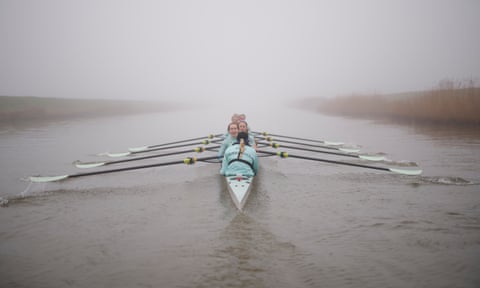
Pulling together: how Cambridge came to dominate the Boat Race – a photo essay
The race along the River Thames between England’s two greatest universities spans 195 years of rivalry and is now one of the world’s oldest and most famous amateur sporting events. Our photographer has been spending time with the Cambridge University Boat Club over the past few months as they prepare for 2024’s races
T he idea of a Boat Race between the two universities dates back to 1829, sparked into life by a conversation between Old Harrovian schoolfriends Charles Merivale, a student at the time at St John’s College Cambridge, and Charles Wordsworth who was at Christ Church Oxford. On 12 March that year, following a meeting of the newly formed Cambridge University Boat Club, a letter was sent to Oxford.
The University of Cambridge hereby challenge the University of Oxford to row a match at or near London each in an eight-oar boat during the Easter vacation.
From then, the Cambridge University Boat Club has existed to win just one race against just one opponent, something Cambridge has got very good at recently. Last year the Light Blues won every race: the open-weight men’s and women’s races, both reserve races, plus both lightweight races – six victories, no losses, an unprecedented clean sweep. Cambridge women’s open-weight boat, or blue boat, has won the last six Boat Races while the men’s equivalent have won five out of the last seven. In such an unpredictable race, where external factors can play a large part, this dominance is startling.

Thames trials
Rough water as the two women’s boats make their way along the River Thames near Putney Embankment during the Cambridge University Boat Race trials.
It’s a mid-December day by the River Thames. The sky and water merge together in a uniform battleship grey and the bitter north wind whips the tops off the waves. Outside a Putney boathouse two groups of tense-looking women dressed in duck-egg blue tops and black leggings with festive antlers in their hair are huddling together, perhaps for warmth, maybe for solidarity. The odd nervous bout of laughter breaks out. For some of them this is about to be their first experience of rowing on the Tideway, a baptism of fire on the famous stretch of London water where the Boat Race takes place. “Perfect conditions,” remarks Paddy Ryan, the head coach for Cambridge University women, for this is trial eights day, when friends in different boats duel for coveted spots in the top boat.
A couple of hours later these women along with their male equivalents will have pushed themselves to the absolute limit, so much so that several of the men are seen trying to throw up over the side of their boats at the finish under Chiswick Bridge. This may be brutal but it’s just the start. For these students the next few months are going to be incredibly tough, balancing academic work with training like a professional athlete. Through the harshest months of the year they will be focused on preparing for the end of March and a very simple goal: beating Oxford in the Boat Race.
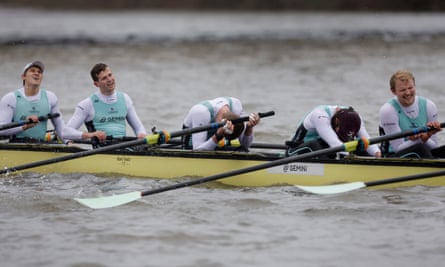
Agony for one of the men’s boats after the finish of the race near Chiswick Bridge during the Cambridge University Boat Race trials.

Ely early mornings
Two of the women’s boats head out in the early morning for a training session on the Great Ouse.
Early winter mornings on the banks of the Great Ouse, well before the sun has risen, can be pretty bleak. In the pitch black a batch of light blue minivans drop off the men and women rowers together at the sleek Ely boathouse that was opened in 2016 at the cost of £4.9m – it’s here that all Cambridge’s on-water training takes place. Very soon a fleet of boats carrying all the teams takes to the water for a training session that may last a couple of hours. Then it’s a quick change, a lift to the train station and back to Cambridge for morning lectures.

The women’s squad head into the Ely boathouse after a 6am drop-off.
As a rower descends the stairs to the bays where the boats are stored, there is a clear indication of why it was built and why they are there. “This is where we prepare to win Boat Races,” a sign says. Since this boathouse was built, Cambridge have won 30 of the 37 races across all categories.
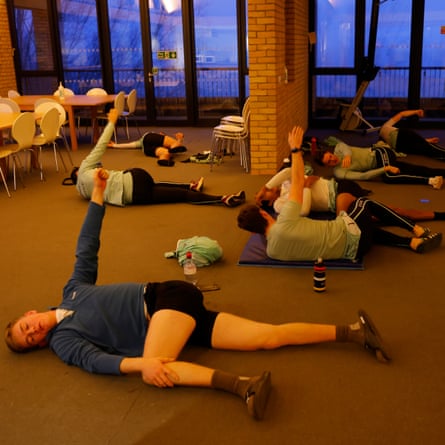
Top: The men’s squad stretch in the boathouse before an early morning training session and a member of the men’s blue boat descends the stairs into where the boats are kept. Below: One of the men’s teams set off for early morning training and the women’s blue boat rows past the women’s lightweight crew during a training session.
It’s a far cry from the old tin sheds with barely any heating and no showers. These current facilities are impressive, enabling the entire men’s and women’s squads to be there at the same time and get boats out.
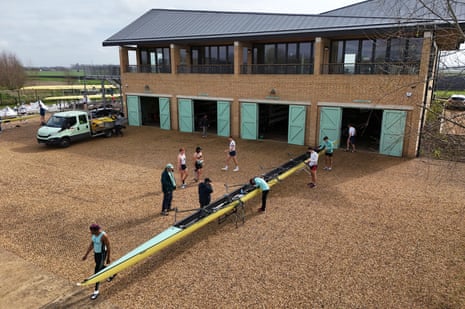
Top: The men’s blue boat prepare to derig their boat at their Ely training site. Above: The women’s blue boat put their vessel back in the boathouse after a training session on the Great Ouse.
But it’s not just the boathouse that has contributed so much, it’s also the stretch of water they train on. In a year when floods have affected so many parts of the country it has really come into its own. Paddy Ryan, the chief women’s coach, explains: “Along this stretch the river is actually higher than the surrounding land. The water levels are carefully managed by dikes and pumps. As a result we haven’t lost a single session to flooding. That’s not the case for Oxford. I believe their boathouse has been flooded multiple times this year, unable to get to their boats. We’ve had multiple storms but we’ve been able to row through them all.”

The men’s third boat practises on the Great Ouse.
It’s a flat, unforgiving landscape, especially in midwinter, definitely not the prettiest stretch of water, but Cambridge don’t care. Ryan says: “It might be a little dull on the viewing perspective but we could row on for 27km before needing to turn round. We have a 5km stretch that is marked out every 250m. We are lucky to have it.”

The men’s blue boat practise their starts on the long straight on the Great Ouse.

The sweat box
Members of the men’s squad check on their technique with the use of a mirror at the Goldie boathouse.
The old-fashioned Goldie boathouse is right in the centre of Cambridge perched on the banks of the River Cam. Built in 1873, its delicate exterior belies what goes on inside. This is the boat club’s pain cave, where the rowers sweat buckets, pushing themselves over and over again; it’s a good job the floor is rubberised and easy to wipe clean.
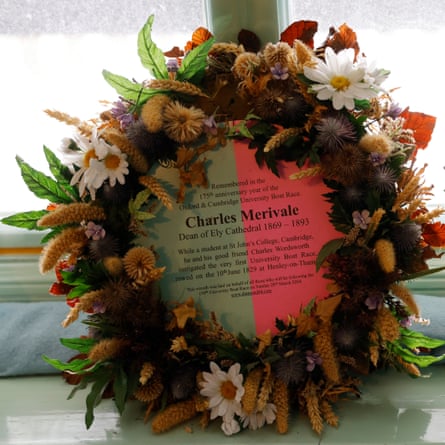
A wreath to Charles Merivale, the founder of the Boat Race, and wood panelling in the upstairs room at the Goldie boathouse which commemorates Cambridge crews that have competed in the Boat Race from 1829.

(Top) Seb Benzecry, men’s president of the Cambridge University Boat Club, and (above) Martin Amethier, a member of the reserve Goldie crew, sweat during sessions on ergo machines.

Iris Powell of the women’s blue boat (above) performs pull-ups during a training session.

Above left: Hannah Murphy, the cox of the women’s blue boat, urges on four of her crew (left to right) Gemma King, Megan Lee, Jenna Armstrong and Clare Hole, as they undertake a long session on the ergo machines. Above right: Kenny Coplan, a member of the men’s blue boat crew, looks exhausted then writes in his times after his session on an ergo machine (below).
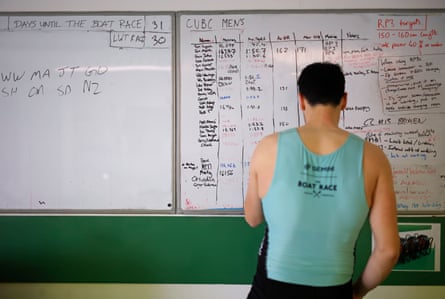
Brutal sessions on the various ergo machines, where thousands of metres are clocked and recorded, are a staple of the training regime set in place. If there is any slacking off the students just need to look up at one of the walls where a map of the Boat Race course hangs. The “S” shape of the Thames has been carefully coloured in the correct shade of blue and record timings for various key points on the course have been written in for both men and women. All but one record, and that one is shared, is held by Cambridge.

Paddy Ryan, the women’s chief coach, talks to the women’s blue boat during a training session on the River Great Ouse in February.
A key ingredient in any successful team is the coaching. Cambridge’s setup is stable and well established. Paddy Ryan is the chief women’s coach, a genial, tall Australian, he has been part of the women’s coaching team since 2013. The care and devotion to his squad is perfectly clear. “I have my notebook next to my bed so I can jot things down. I wake up in the middle of the night going: am I making the right decisions? I care about them as people and I need to manage them … We joke as coaches that we are teaching some of the smartest people on the planet how to pull on a stick.”
Rob Baker, the chief men’s coach, has Cambridge rowing in the blood. Born and bred in the city, his father was a university boatman for 25 years. He even married into the sport – his wife, Hayley, rowed for Cambridge as a lightweight – so it was no surprise that he became part of the coaching setup way back in 2001. He was the first full-time women’s coach in 2015 then moved to take over the men in 2018.
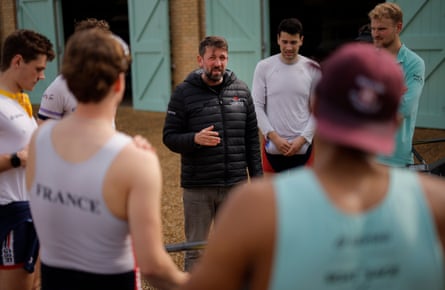
Rob Baker, the men’s chief coach, talks to his blue boat at their Ely training site.
Apart from an obvious role in the development of rowing skills, a key part of their job is making sure there is a balance for their student athletes. They understand they have to juggle training needs. “Every week we have a general plan,” says Baker, “but then someone might have an extra class or supervision they’ve got to do so we have to move around it. They are studying at one of the most competitive universities in the world with the highest standards so you’ve got to give them space to do that properly.” He goes on: “But when they get on the start line for their race, they’ll be just as competitive as if they were professionals.”
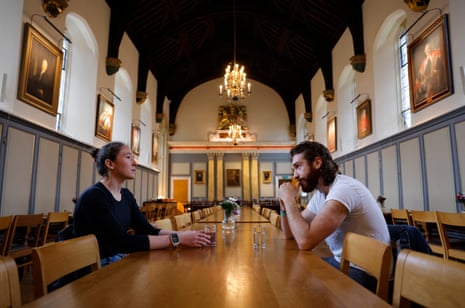
The presidents
Jenna Armstrong and Seb Benzecry discuss their plans in the Great Hall at Jesus College.
Every year one man and one woman are elected presidents to represent Cambridge University Boat Club. They are the captains and leaders, not only responsible for helping design the training programme in conjunction with the coaches but also making budgetary and tactical decisions along the way. This year both of them, Jenna Armstrong and Seb Benzecry, are from the same college, Jesus, which helps the communication between the two of them. They share ideas and knowledge, thoughts and worries. Their lives, for these intense few months, are a juggling act.
Armstrong is a 30-year-old from New Jersey, and doing a PhD in physiology. Once a very keen competitive junior skier she was forced to abandon her hopes of a career on the slopes after a number of serious knee injuries. She only started rowing in 2011 and only became aware of the Boat Race when she saw it on TV a couple of years later.
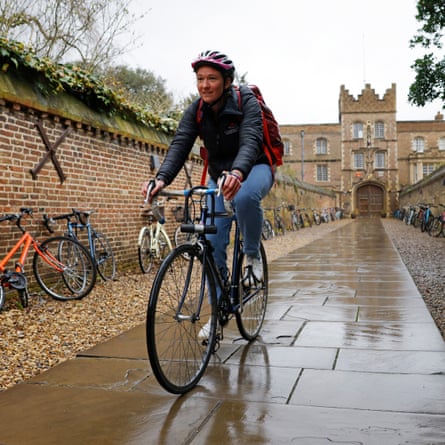
Jenna Armstrong, cycling down the Chimney, the grand entrance to Jesus College, to go to the other side of the city to carry out more of her PhD research at the department of physiology, development and neuroscience.
The research she carries out at the university labs could be turn out to be life-saving. “I study mitochondrial function in placentas from women from all over the world to learn how genetic and environmental factors during pregnancy can influence placental metabolism and impact the health of both mother and baby. I’m particularly interested in growth restriction which affects about 10% of babies worldwide. That can have lifelong implications for these babies and currently we don’t have any treatment for this.”
Benzecry, 27, is studying for a PhD in film and screen studies, and comes from a completely different rowing background. He grew up just a stone’s throw from the Boat Race course and went to a school on the banks of the Thames. This will be his 14th year of competitive rowing but his fourth and last Boat Race.
“ I remember one year my birthday fell on race day and we watched after my birthday party. Because we live fairly close to the course, I’ve always felt connected to the race.”

Seb Benzecry stands next to an Antony Gormley statue in the Quincentenary Library at Jesus College as he conducts research for his dissertation which forms part of his PhD in film and screen studies.
Talking about how hard it is to get the right balance between academic student life and rowing, Benzecry says: “I guess you have to accept there are many, many things you can’t do, you just don’t have time for during the season. You have to put the blinkers on.”
Armstrong says: “I have to be very prepared, very strategic and organised. I pack everything the night before, and then once I leave my room in the morning, I don’t go back. That allows me to go to training, go to the lab, go to training again. It’s surreal actually, to come to a place like Cambridge, have one of the best educations in the world on top of the most incredible rowing experiences in the world. We have a thing now in the boat, when we are doing something incredibly hard, I say this is my ideal Saturday, I wouldn’t want to be anywhere else. I would rather be here than in bed or on a date. And I make everyone else say it with me too. I’d rather be nowhere else.”
Benzecry states: “When it’s really bad, when training is so hard, we say Oxford aren’t doing this, they could never do this. It’s an incredibly powerful thing to be thinking we work harder than them, our culture is better than them. They don’t want to go hard as we do – they might think they do but they don’t, they just don’t have it.”
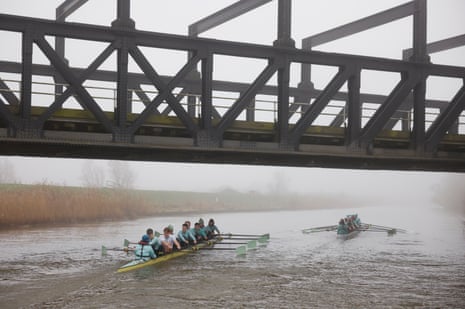
Integration
The men’s and women’s blue boats during a training session on the River Great Ouse in February.
Until 1 August 2020, there were three separate university boat clubs in Cambridge: one for open-weight men, one for lightweight men, and one for open-weight and lightweight women. Since they merged to become one club, it has undoubtedly helped with everyone sharing the same resources and motivating and inspiring one another. No one is more important and everyone has a key part to play in the result. This year, Oxford have followed suit.
Baker says: “I definitely feel, for the athletes themselves, it makes a big difference. They all feel like they’re contributing to one common goal. Every cog in the wheel has to do its job but for sure it feels like one big team on a mission.”
Benzecry explains: “We’re seeing each other train, we’re all out on the water at the same time, we’re supporting each other throughout the season, building a sense of momentum for the whole club towards the races. Everyone’s just inspiring each other all the time and I think that’s been such a sort of cultural shift for Cambridge.”
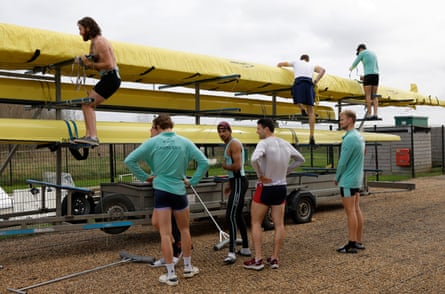
The men’s blue boat pack their craft on to a trailer at their Ely training site ready for the trip down to London for the Boat Race.
Siobhan Cassidy, the chair of the Boat Race, knows from first-hand how the integration has helped. She rowed for the Light Blues in 1995 and had a key role in the transition. “We could see the advantages of working together, collaborating as a bigger team, the positive impact we felt that could have on performance. But not just the output, actually the whole experience for the young people taking part.”
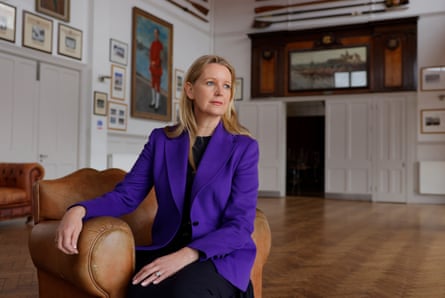
Siobhan Cassidy, the chair of the Boat Race, pictured at the Thames Rowing Club at Putney Embankment.
This Saturday, if the weather holds, an estimated 250,000 people, the vast majority of whom have no allegiance to one shade of blue or the other, will pack the banks of the Thames to see these races. It’s one of the largest free events in Britain. Broadcast live on BBC One, the race is also beamed to 200 countries across the world.
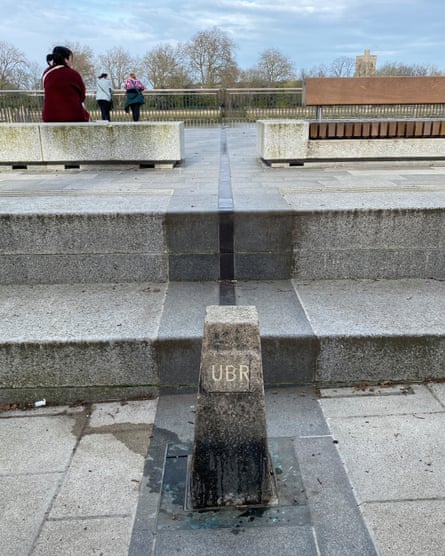
The starting stone for the University Boat Race and pavement inscription: “The best leveller is the river we have in common” at Putney Embankment.
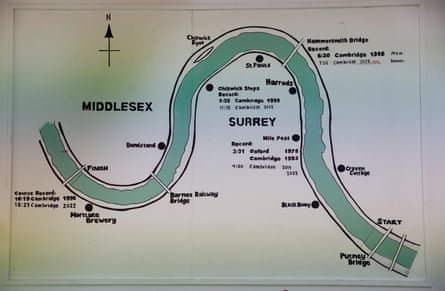
A map of the Boat Race course at the Goldie boathouse, with the Thames coloured in Cambridge blue and record timings written in for men and women showing almost total Cambridge dominance.
A sporting pinnacle being contested on a fast-flowing, unpredictable river by two teams of university students – it’s pretty bizarre. But maybe it’s that quirkiness that keeps the race, after almost two hundred years, still going strong. And even more bizarre to think that Cambridge, the current dominant force in the Boat Race, a sporting event that can’t shrug off its elitist stereotype, owes so much of that success to such egalitarian principles.
- The Guardian picture essay
- The Boat Race
- University of Cambridge
- Photography
Most viewed

IMAGES
VIDEO
COMMENTS
Essay length guidelines. Type of essay. Average word count range. Essay content. High school essay. 300-1000 words. In high school you are often asked to write a 5-paragraph essay, composed of an introduction, three body paragraphs, and a conclusion. College admission essay. 200-650 words.
Writing a long essay of 3,000 words can be done in a day if you just put your mind to it. Do the following: Don't schedule any other appointments or assignments for the day. Put away any potential distractions, like your phone or the TV. Stay off of social media. Work somewhere quiet, like the library or a calm cafe.
Revised on June 1, 2023. Most college application portals specify a word count range for your essay, and you should stay within 10% of the upper limit. If no word count is specified, we advise keeping your essay between 400 and 600 words. You should aim to stay under the specified limit to show you can follow directions and write concisely.
In the simplest terms, your college essay should be pretty close to, but not exceeding, the word limit in length. Think within 50 words as the lower bound, with the word limit as the upper bound. So for a 500-word limit essay, try to get somewhere between 450-500 words. If they give you a range, stay within that range.
The essay writing process consists of three main stages: Preparation: Decide on your topic, do your research, and create an essay outline. Writing: Set out your argument in the introduction, develop it with evidence in the main body, and wrap it up with a conclusion. Revision: Check your essay on the content, organization, grammar, spelling ...
Sentence length will vary based on the paper type you're working on. In narrative essays, you have to tell a story, which means sentences can be very long (up to 50 words). But general advice would be to keep sentences shorter than 25 words. Considering that, a 500-word essay would have somewhere between 20 to 45 sentences.
These essays tend to be around 250 words, but some may be just as long as your main essay. For example, Cornell requires applicants to write a second supplemental essay (of 650 words max) that is specific to the program they're applying to. The exception to this is the Cornell College of Engineering, for which applicants are required to ...
If your institution doesn't provide a specific word count, it's best to keep your essay between the length established by the longer college admissions essay format: 250 to 650 words. Word count is just one factor to consider as you craft your college admissions essay. Let's go over other considerations, like whether a longer essay makes ...
Increasing the size of periods and commas. This is one of the less noticeable tricks you can use. For instance, if your paper's font is 12 pt., increase it to 14 pt. only for punctuation marks. Italicizing periods and commas will also add several lines of length to your essay.
4. The Extended Essay. The extended essay is the most common type of essay that's assigned during a bachelor's or master's degree, and it may be of any length - although it's unusual for such essays to be above 5,000 words.The most common lengths for an extended essay are 1,500, 3,000 and 5,000 words, with a word count allowance of plus or minus 10%.
Tackling long essays can become easy by following the following steps: 1. Pick a Topic. When granted the freedom to choose a topic, pick a broad and specific one. It is easy to find and write about a broad topic. Topics with scarce research material generate little content and are not suitable for long essays.
Jeffrey R. Wilson's Academic Writing is a no-nonsense guide to the long and complex writing process. Packed with concrete examples, helpful visuals, and practical tips, the book is an essential guide for academic ... - Into the Essay: Excerpts from actual papers show the ideas from the chapters in action because you learn to write best by ...
An essay is, generally, a piece of writing that gives the author's own argument, but the definition is vague, ... One definition is a "prose composition with a focused subject of discussion" or a "long, systematic discourse". It is difficult to define the genre into which essays fall.
This essay begins by discussing the situation of blind people in nineteenth-century Europe. It then describes the invention of Braille and the gradual process of its acceptance within blind education. Subsequently, it explores the wide-ranging effects of this invention on blind people's social and cultural lives.
The essay is a written piece that is designed to present an idea, propose an argument, express the emotion or initiate debate. It is a tool that is used to present writer's ideas in a non-fictional way. Multiple applications of this type of writing go way beyond, providing political manifestos and art criticism as well as personal ...
So, "How long is an essay?" Well, that's a question for many. The length of an essay depends on various factors, such as the student's degree, essay topic, and type. Essays assigned to school students are quite short compared to any college essay. However, there is a thin line that should be maintained while writing an essay.
The College Board's characteristics of a high-scoring long essay question response are listed below. Note that the requirements are very similar to those of the DBQ; the primary difference is that any requirements related to use of the documents are removed from the scoring requirements for the long essay question.
Long essay is a very lengthy write-up on a topic. In tertiary institutions long essay implies writing a project, dissertation or thesis. It is often one of the graduation requirements a student ...
The "longform" label offers readers and writers a new way to self-identify, and a new hashtag by which they may find, distinguish and promote stories. An attendant risk is that a story's appeal as a "longform" product could short-circuit editorial judgment and damage a writer or his subject before a large audience.
The basic structure of an essay always consists of an introduction, a body, and a conclusion. But for many students, the most difficult part of structuring an essay is deciding how to organize information within the body. This article provides useful templates and tips to help you outline your essay, make decisions about your structure, and ...
A (very long) essay on political communications, French style. Post. 19 October 2011. Posted by Alastair Campbell. 9. The post has just arrived and in it a very nice surprise, the discovery that Jacques Seguela, one-time adviser to President Mitterrand, now close confidant of President and Madame Sarkozy (indeed he intoduced them), and ...
Morgan Parker Says 'Poetry Is Under Everything' She Writes. Crafting the arguments in "You Get What You Pay For," her first essay collection, "felt like pulling apart a long piece of ...
Today, Andrew Huberman is a stiff, jacked 48-year-old associate professor of neurology and ophthalmology at the Stanford University School of Medicine. He is given to delivering three-hour ...
An essay is a focused piece of writing that explains, argues, describes, or narrates. In high school, you may have to write many different types of essays to develop your writing skills. Academic essays at college level are usually argumentative: you develop a clear thesis about your topic and make a case for your position using evidence ...
Netanyahu, a self-described expert on the U.S., is taking U.S. support for granted—in the belief that Evangelical Christians and America's tiny Jewish minority will ensure that Israel is ...
Above left: Hannah Murphy, the cox of the women's blue boat, urges on four of her crew (left to right) Gemma King, Megan Lee, Jenna Armstrong and Clare Hole, as they undertake a long session on ...
Step 1: Hook your reader. Step 2: Give background information. Step 3: Present your thesis statement. Step 4: Map your essay's structure. Step 5: Check and revise. More examples of essay introductions. Other interesting articles. Frequently asked questions about the essay introduction.